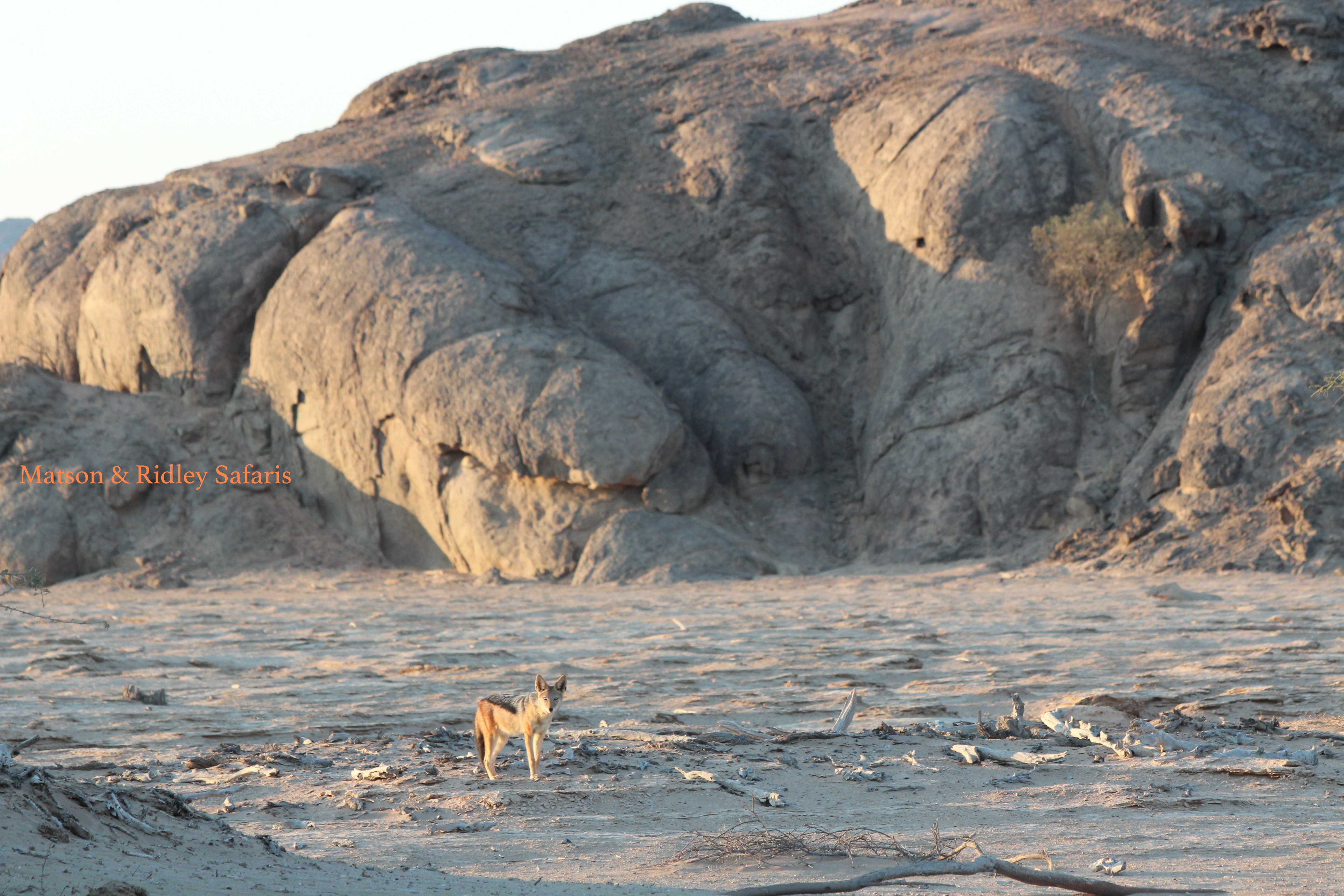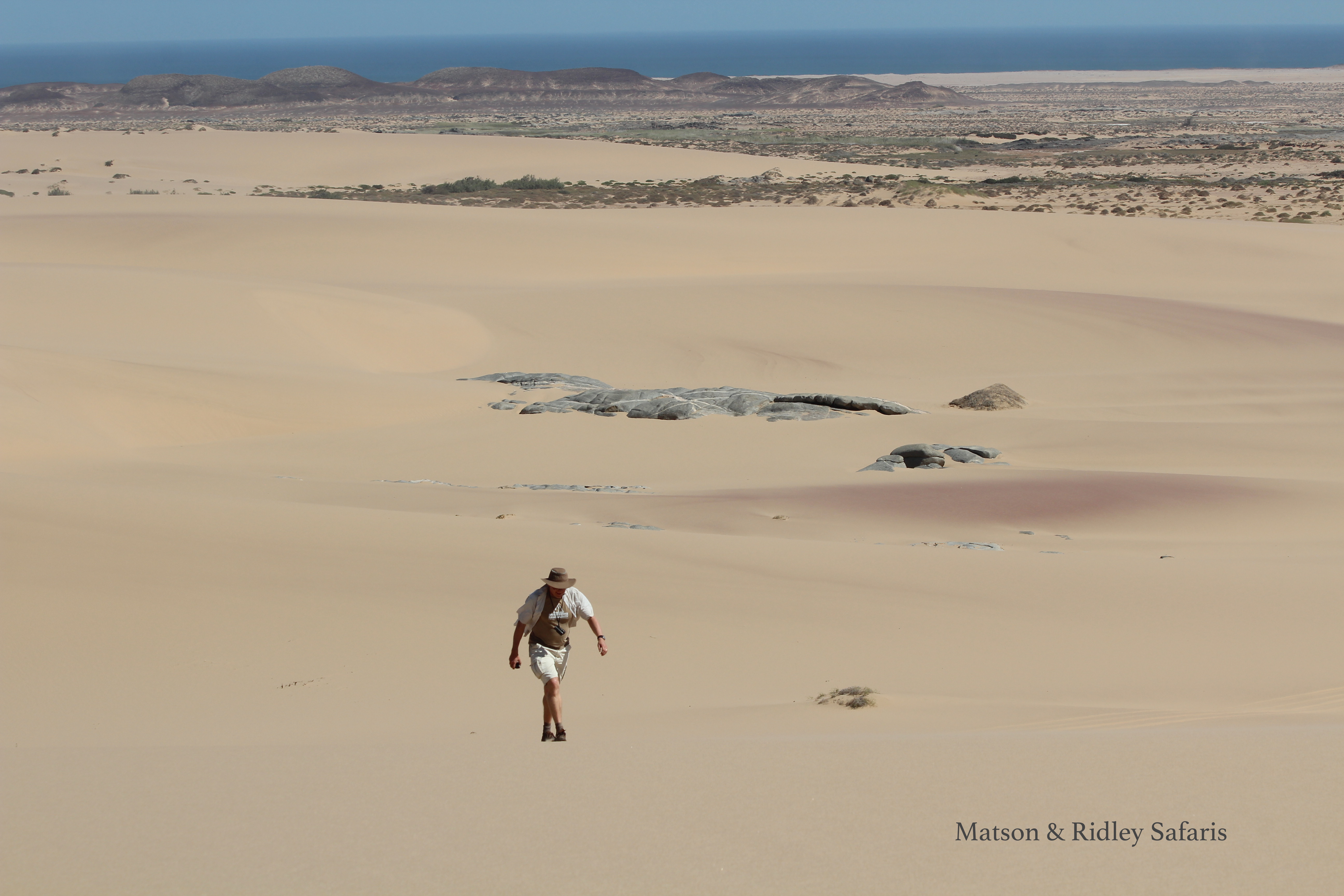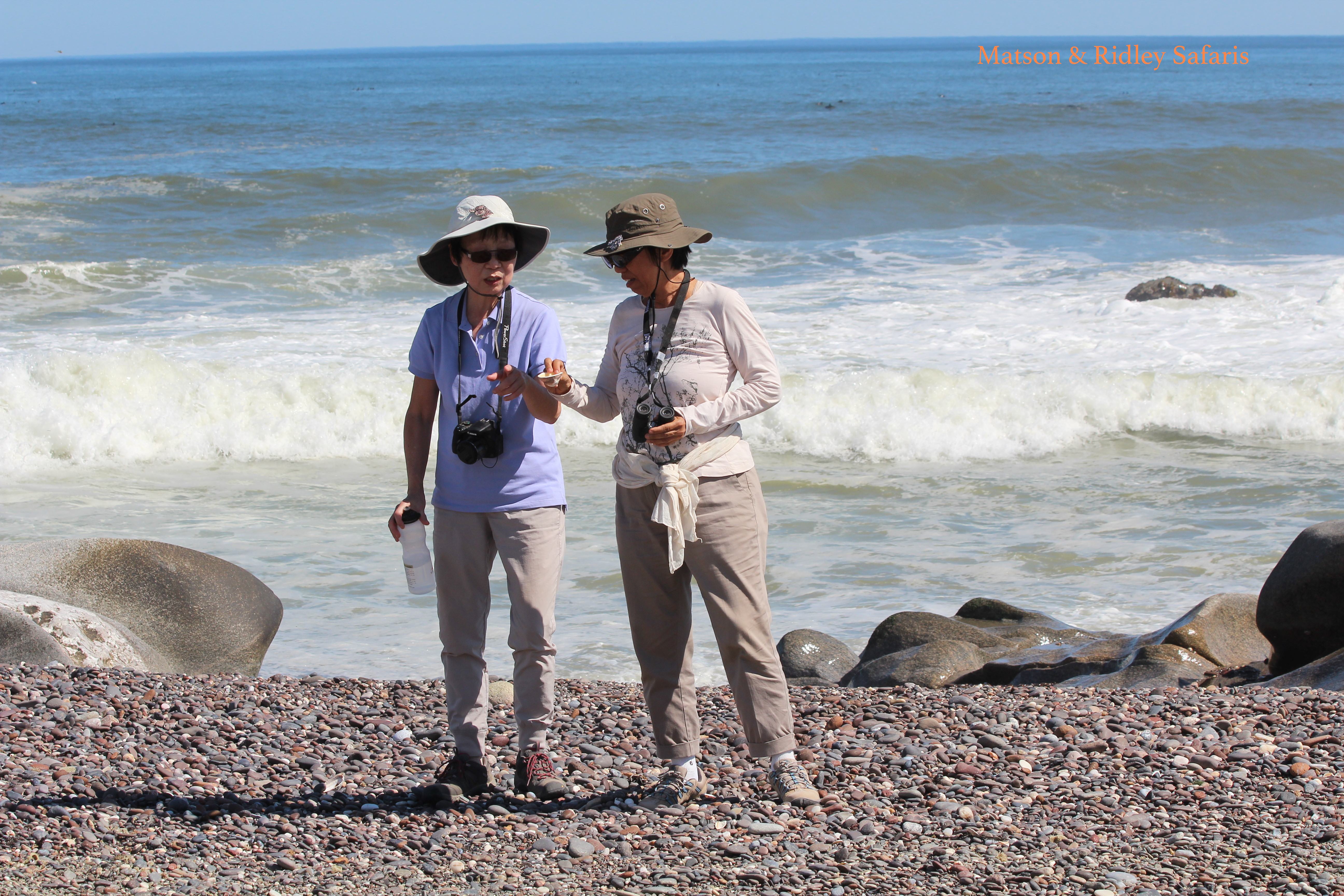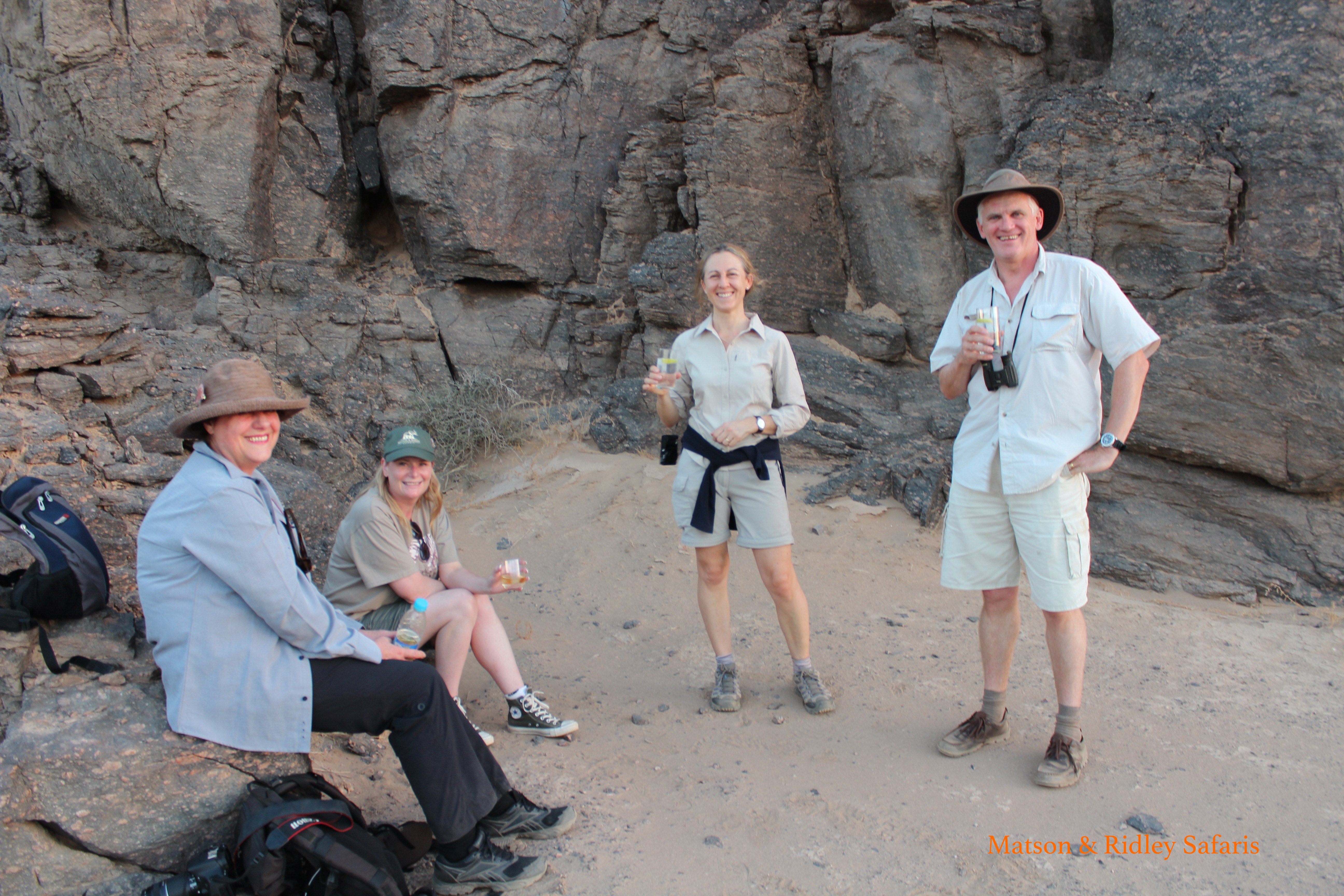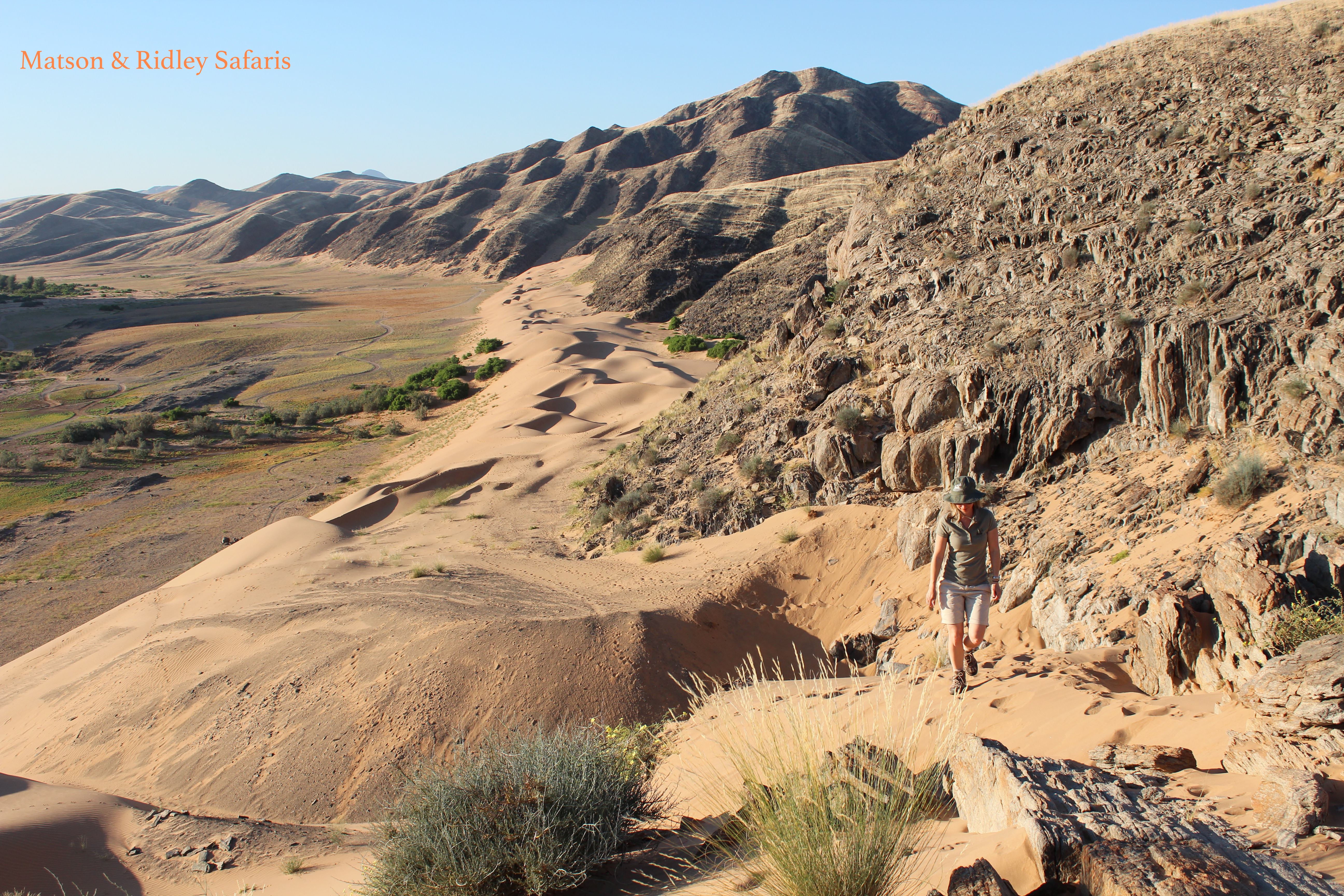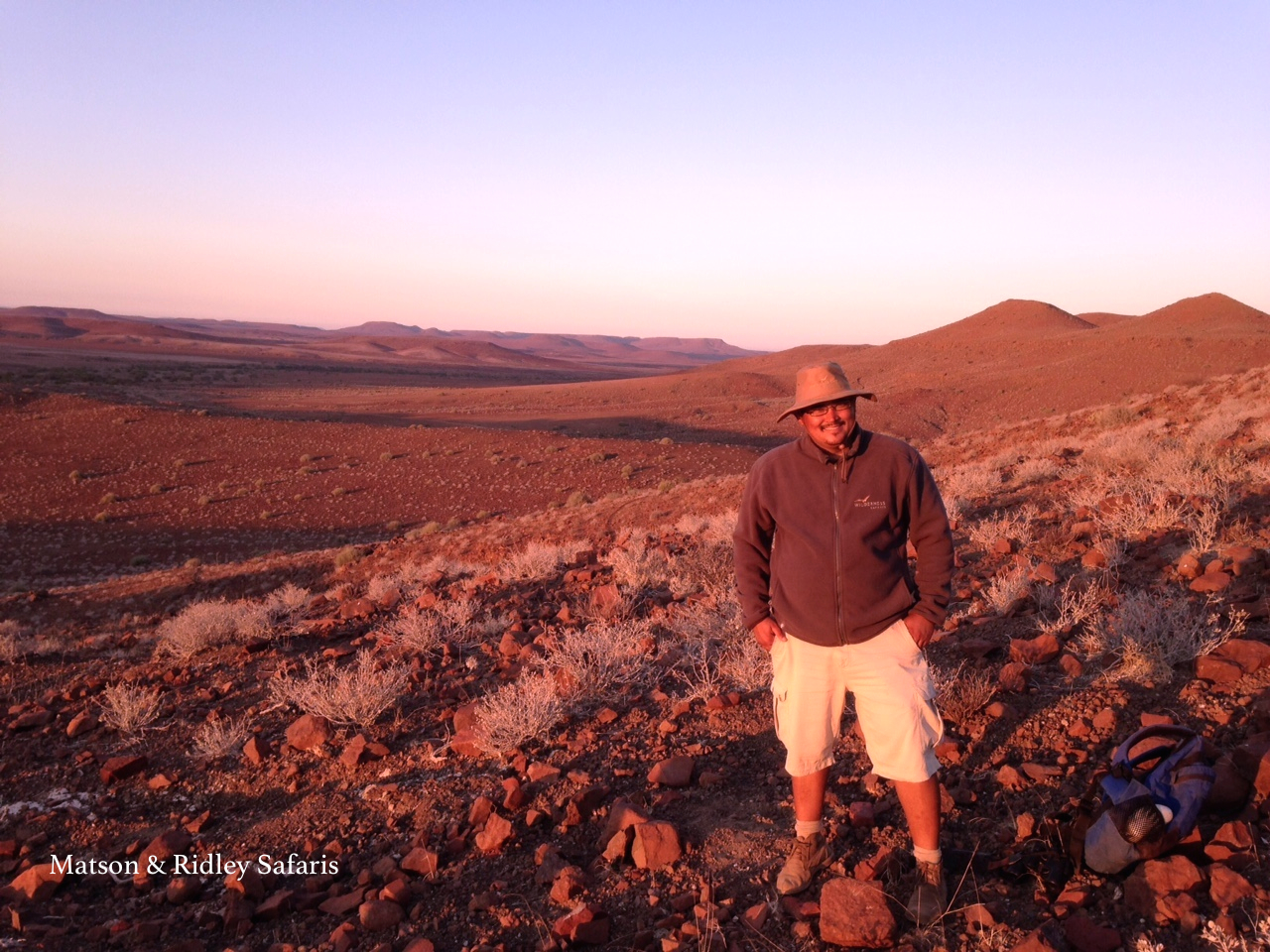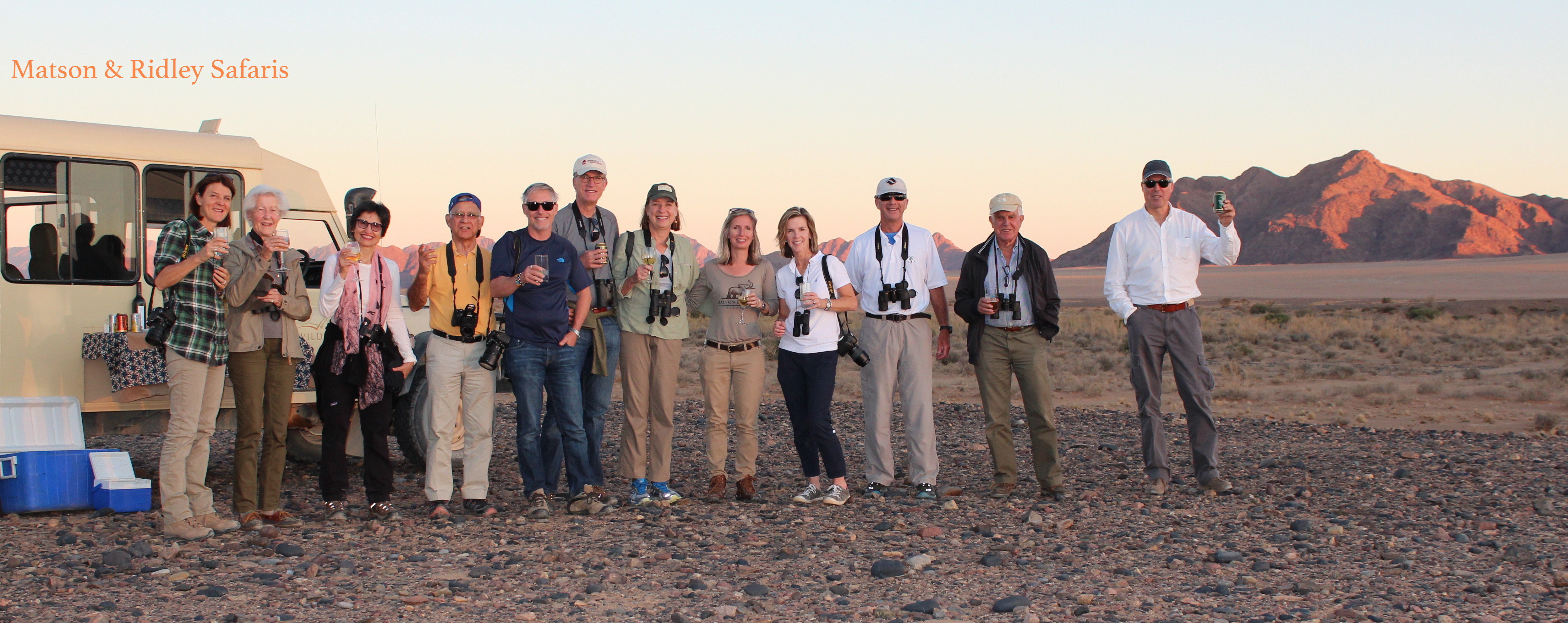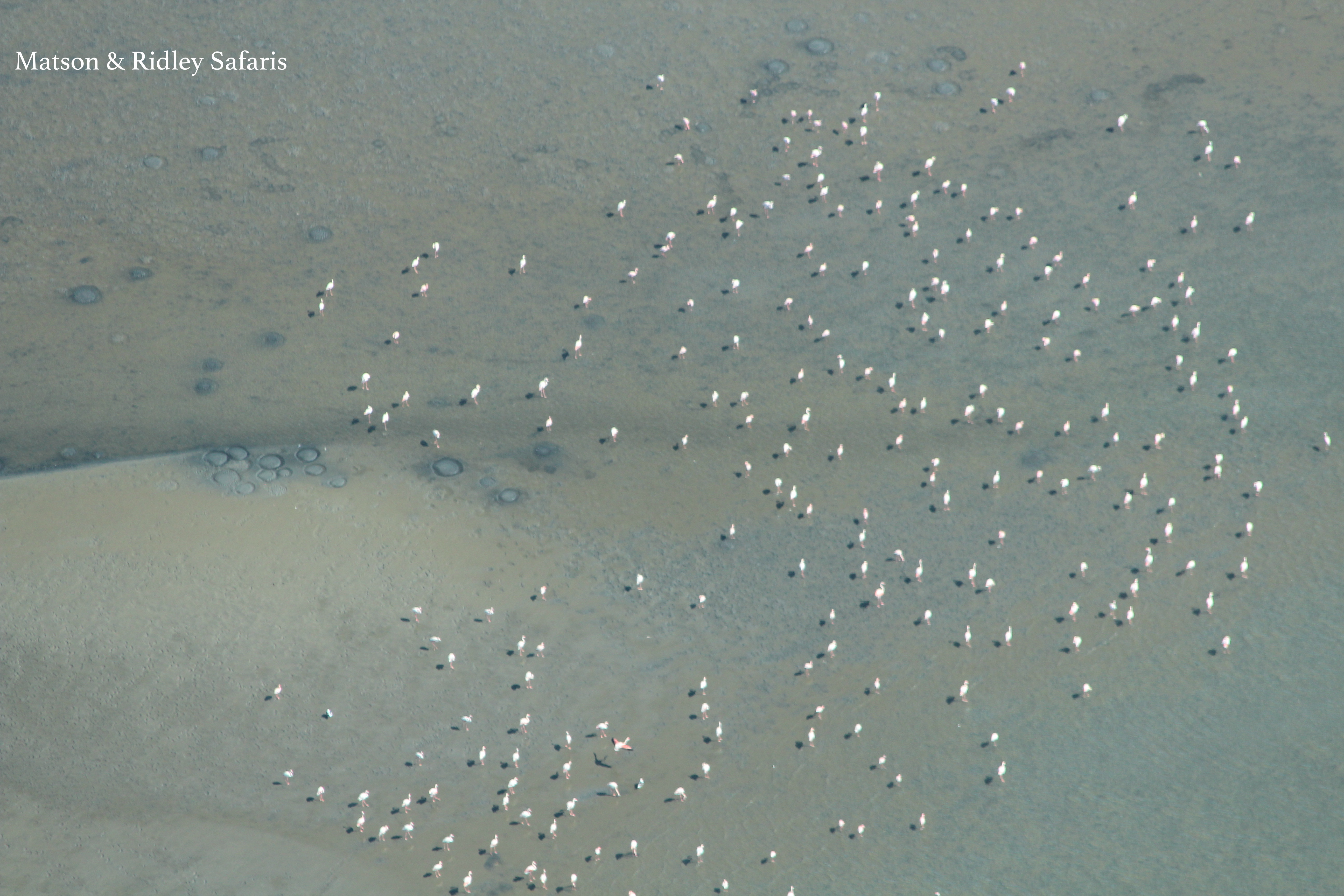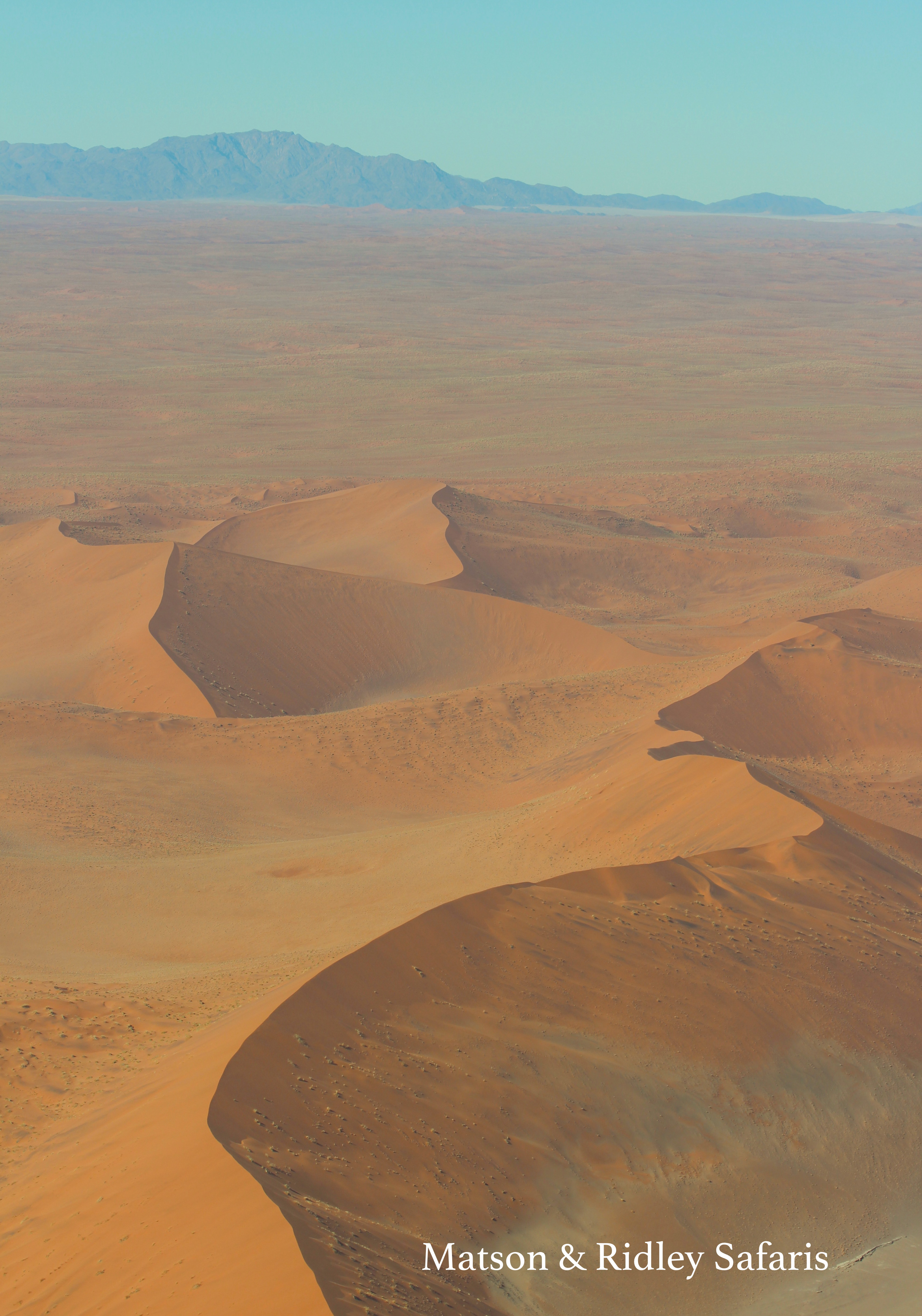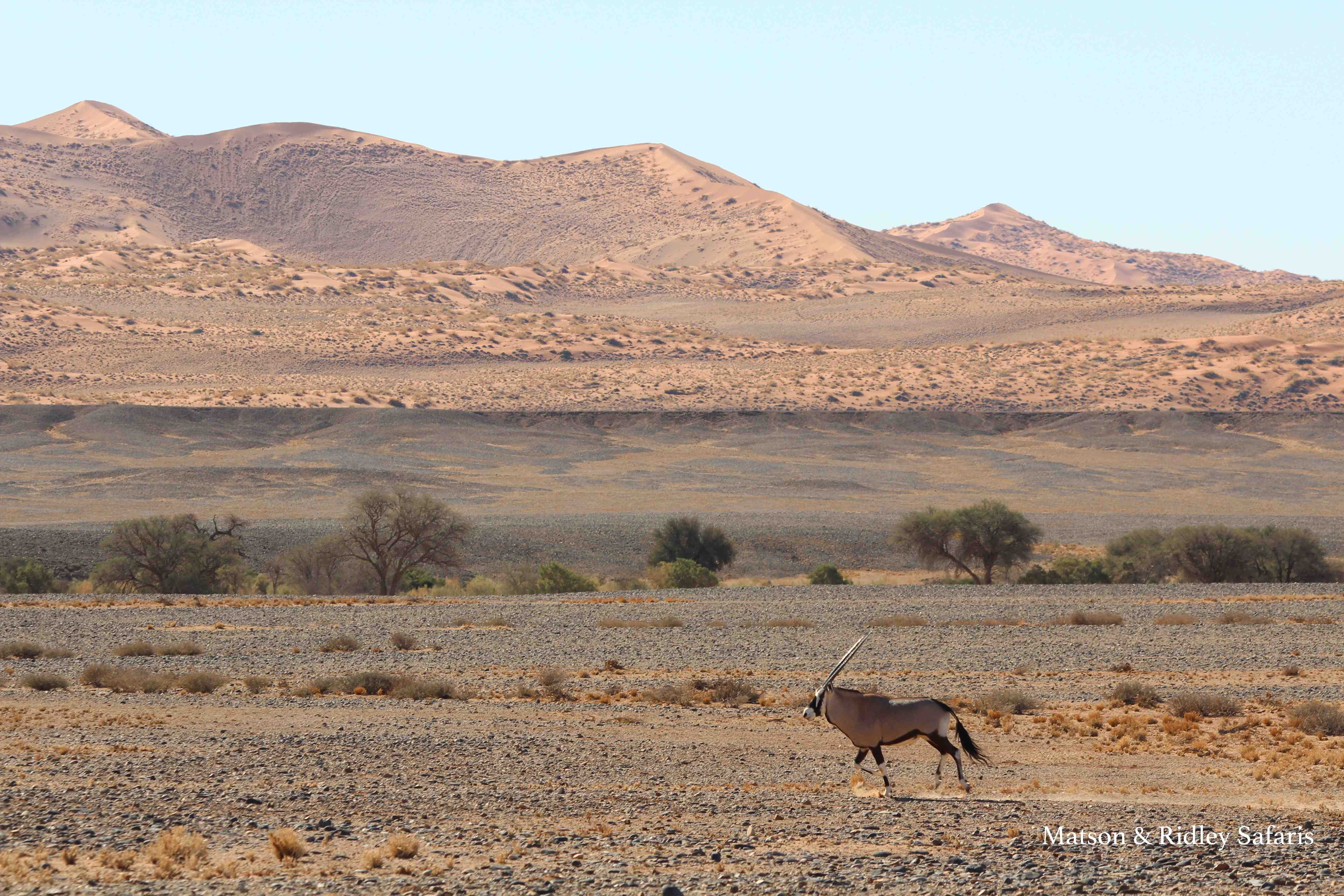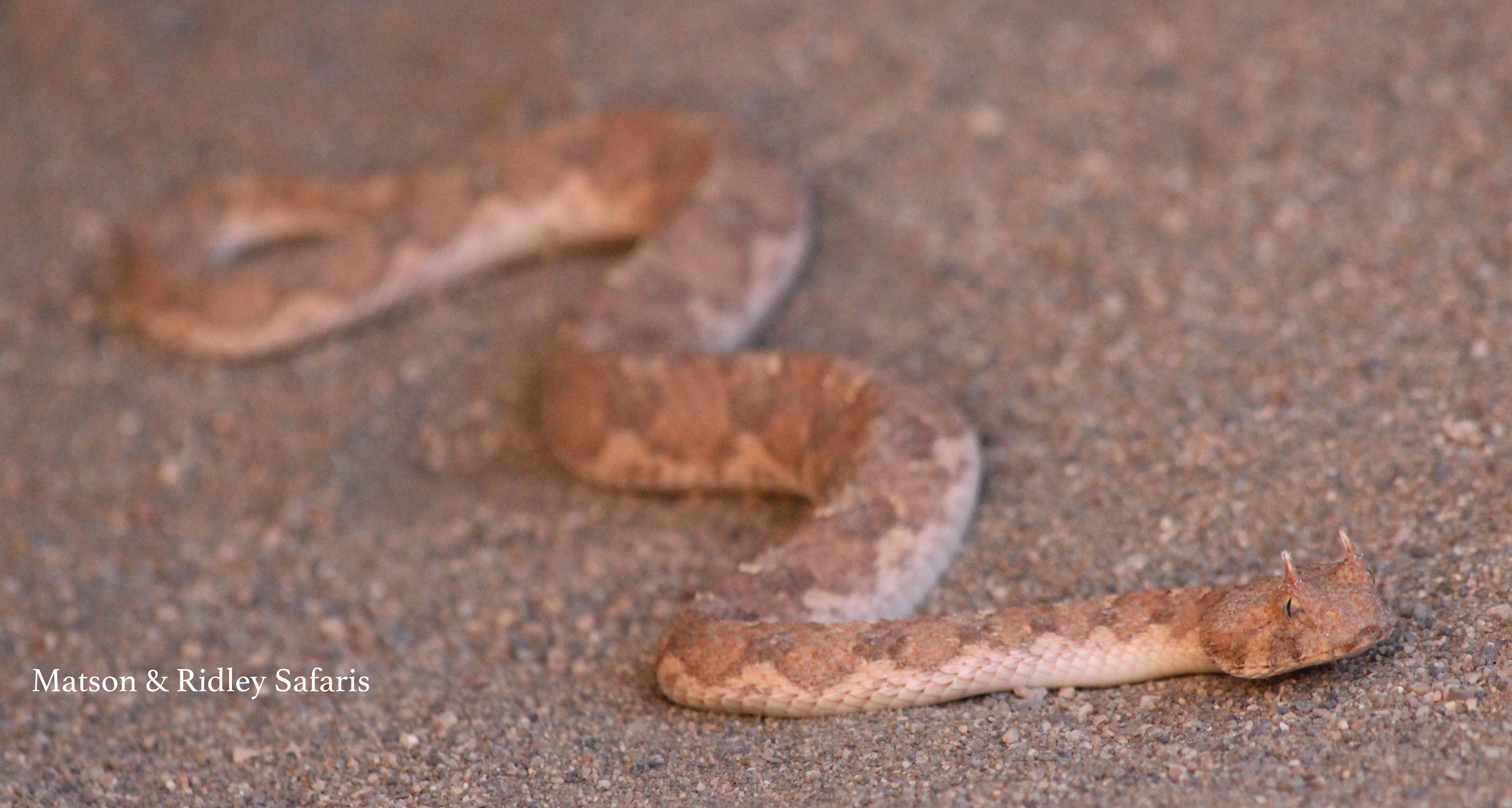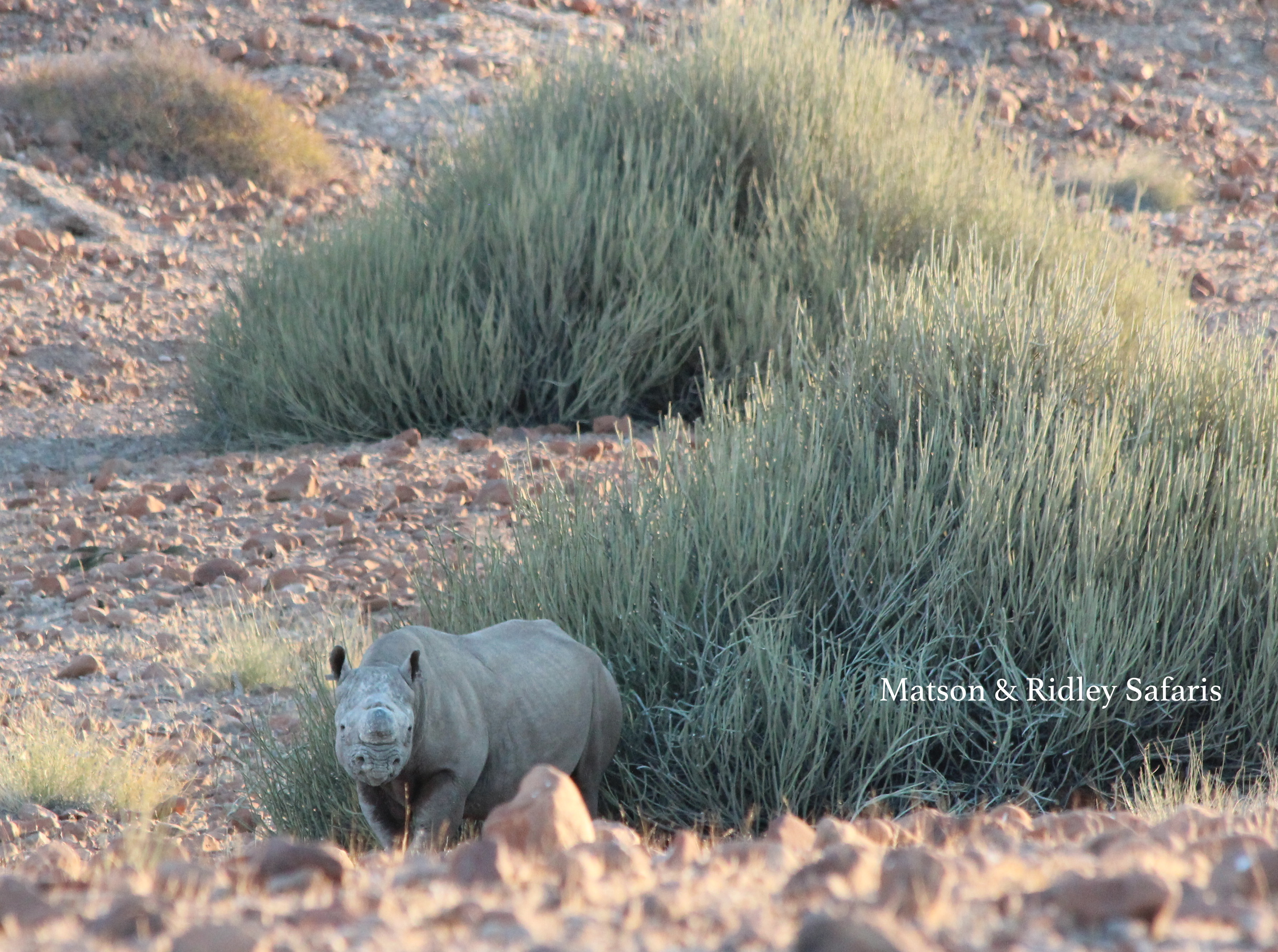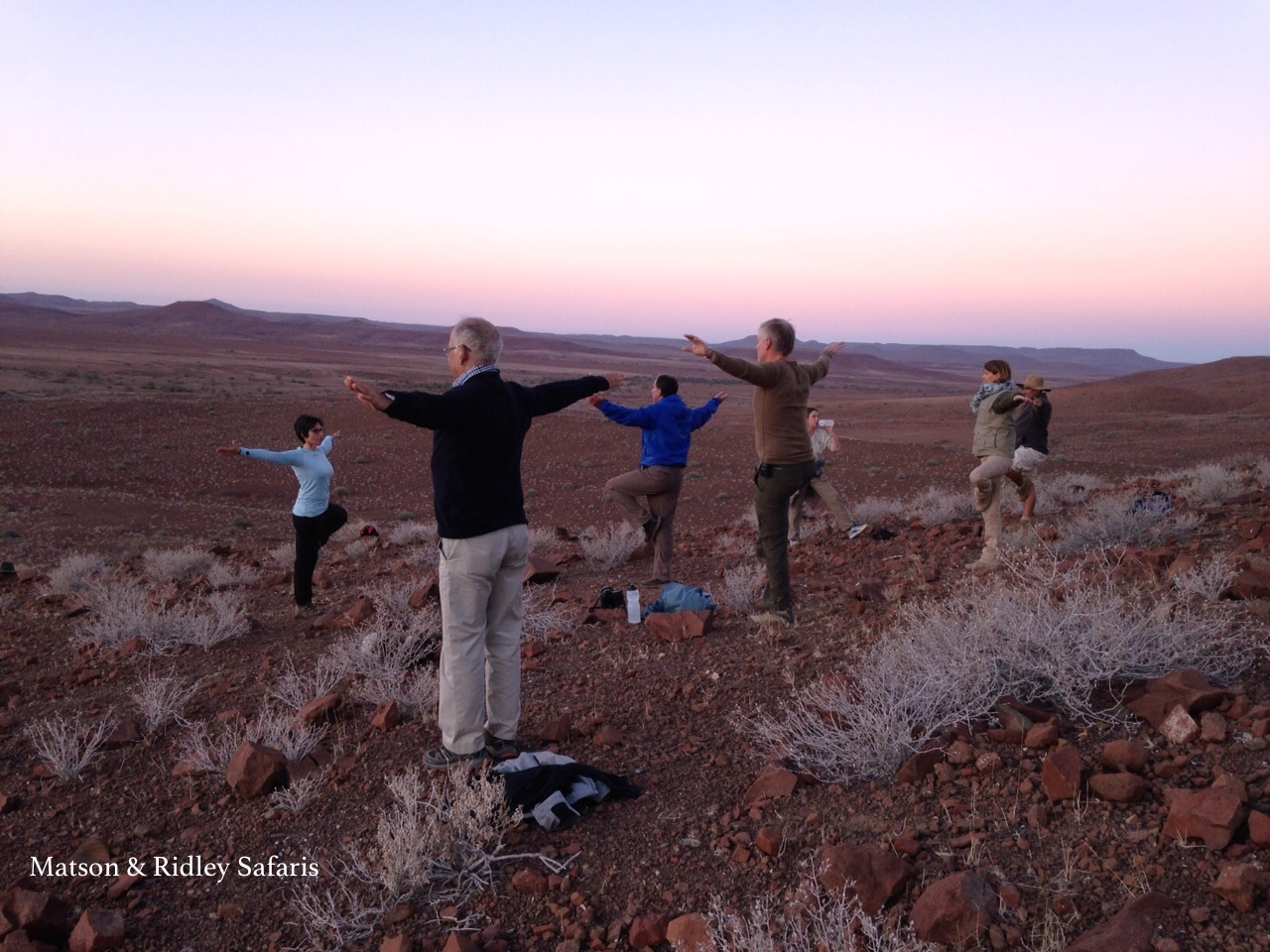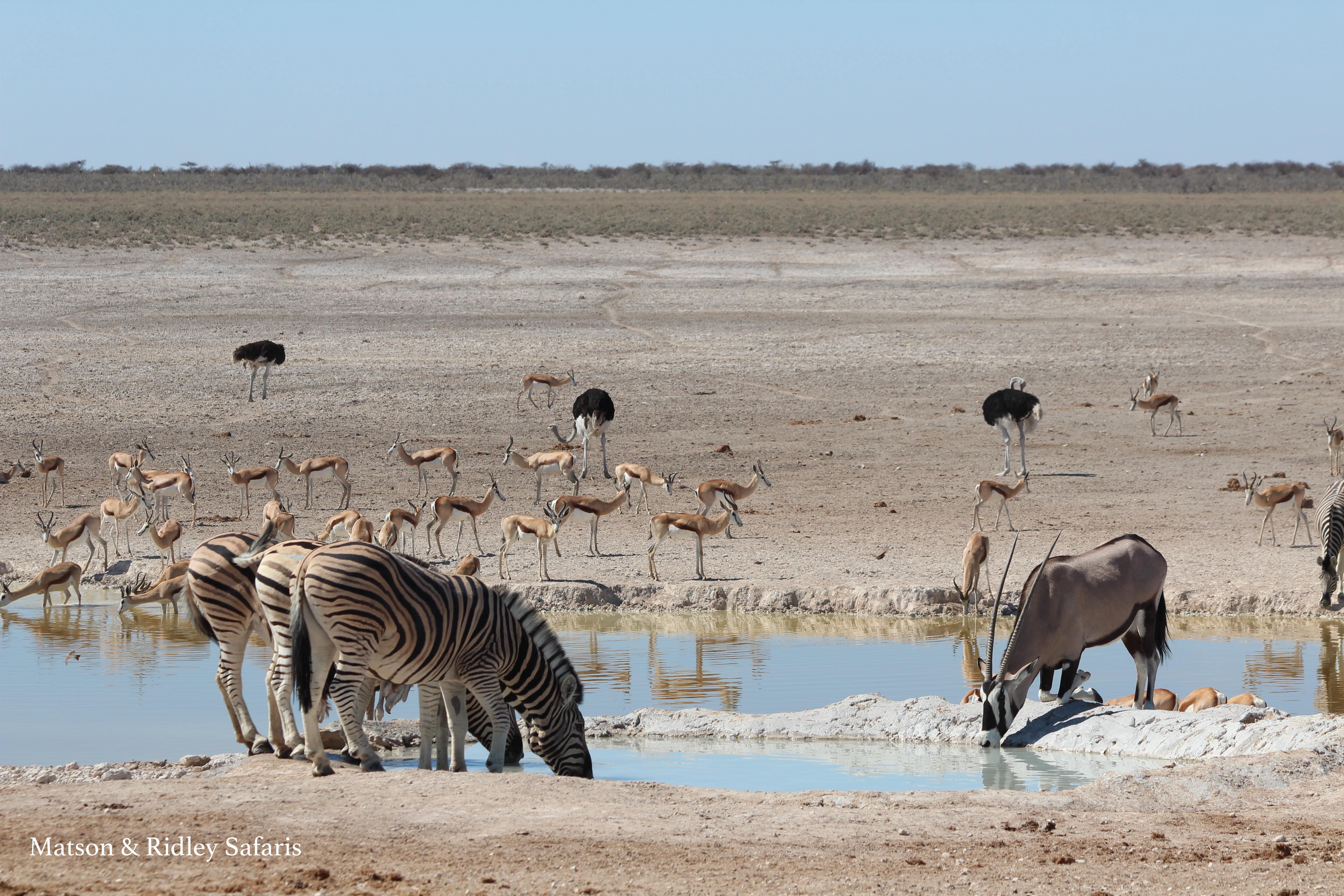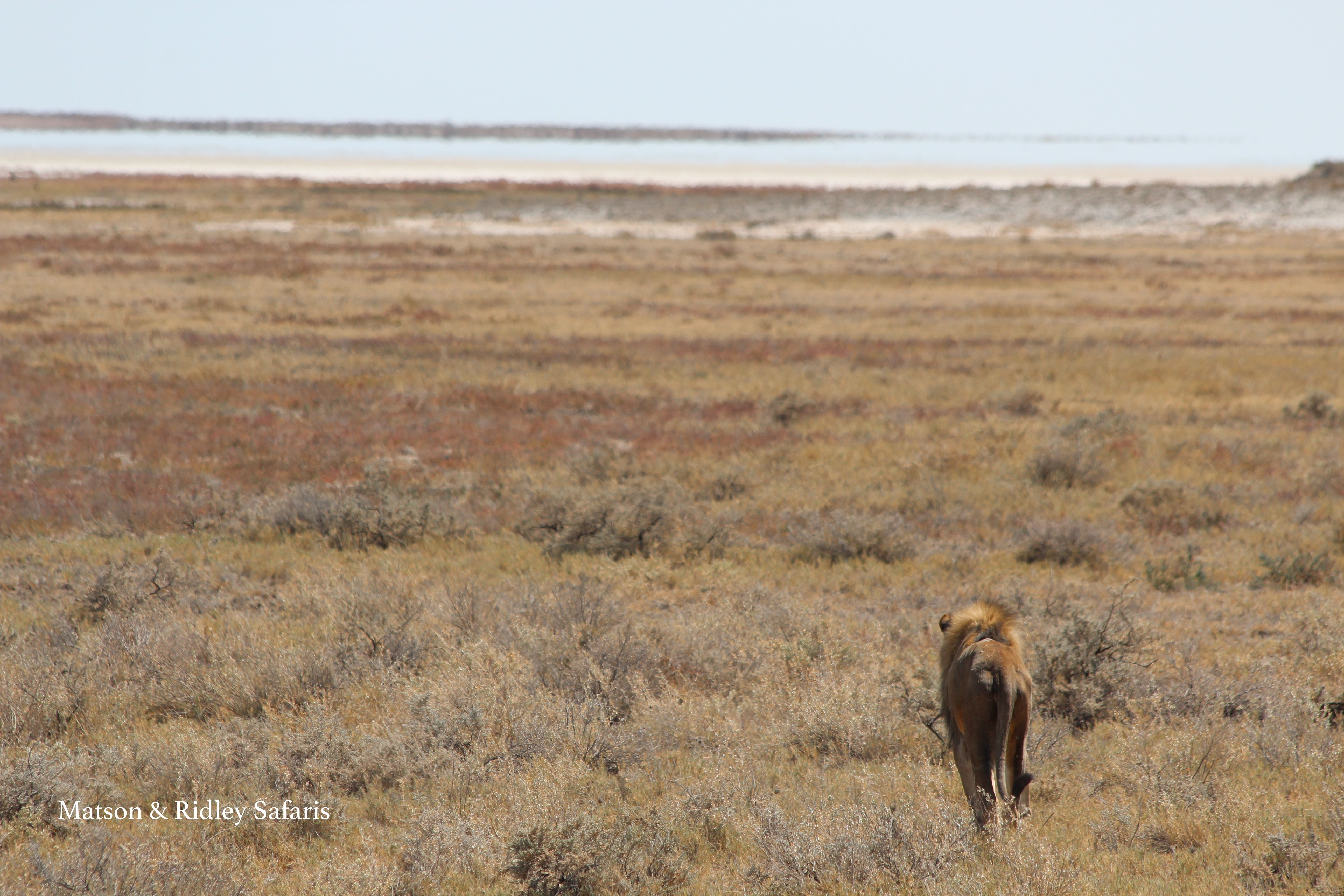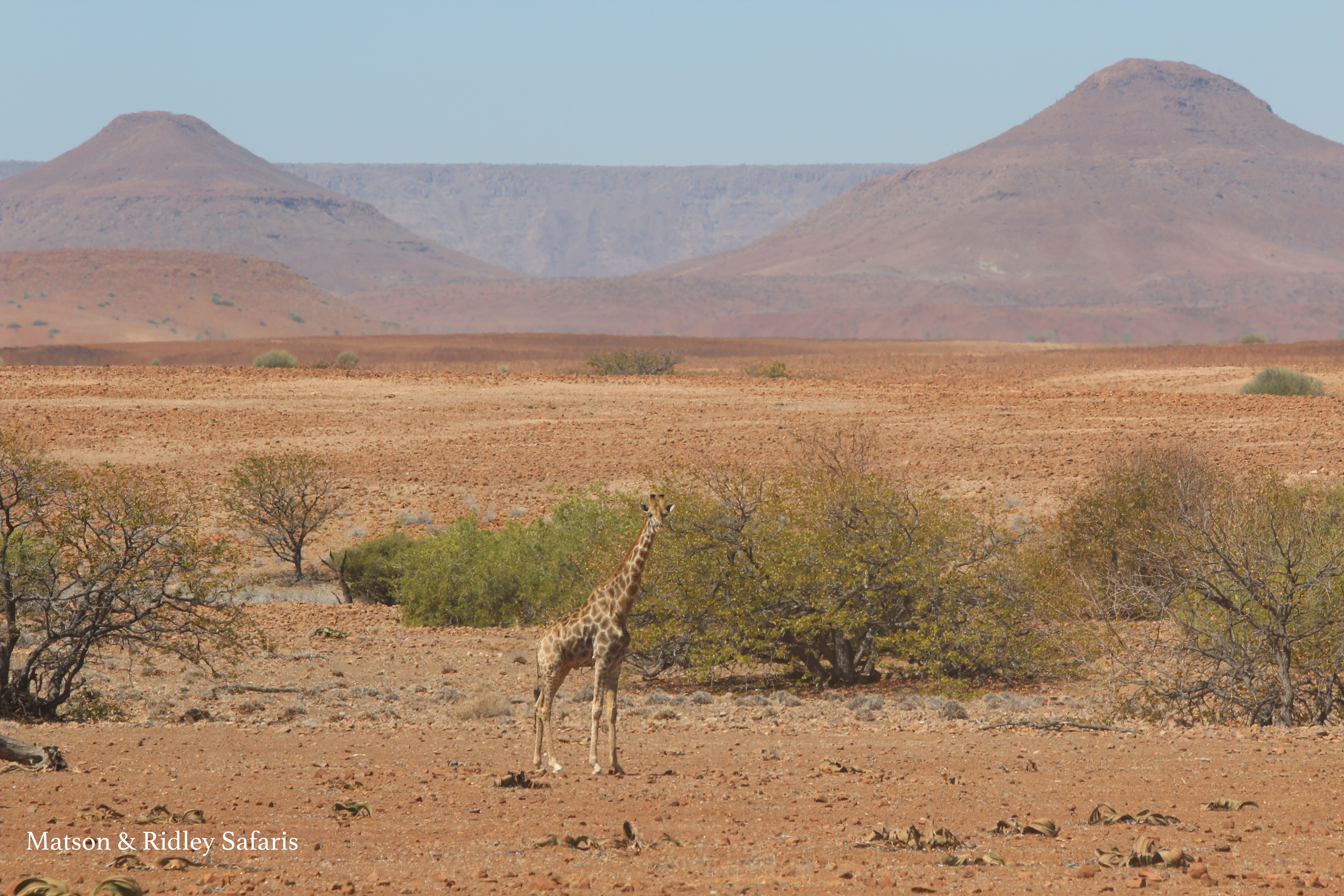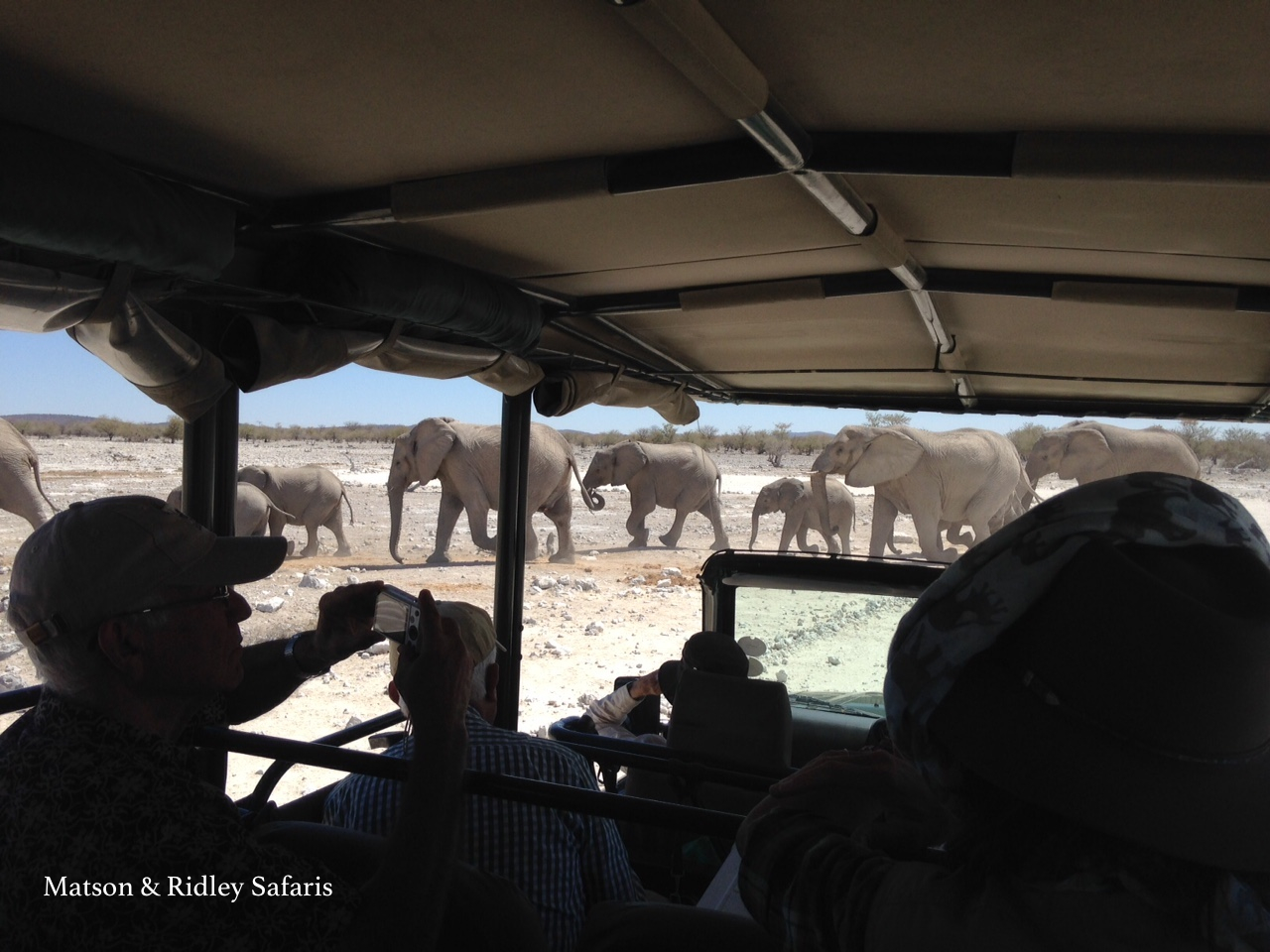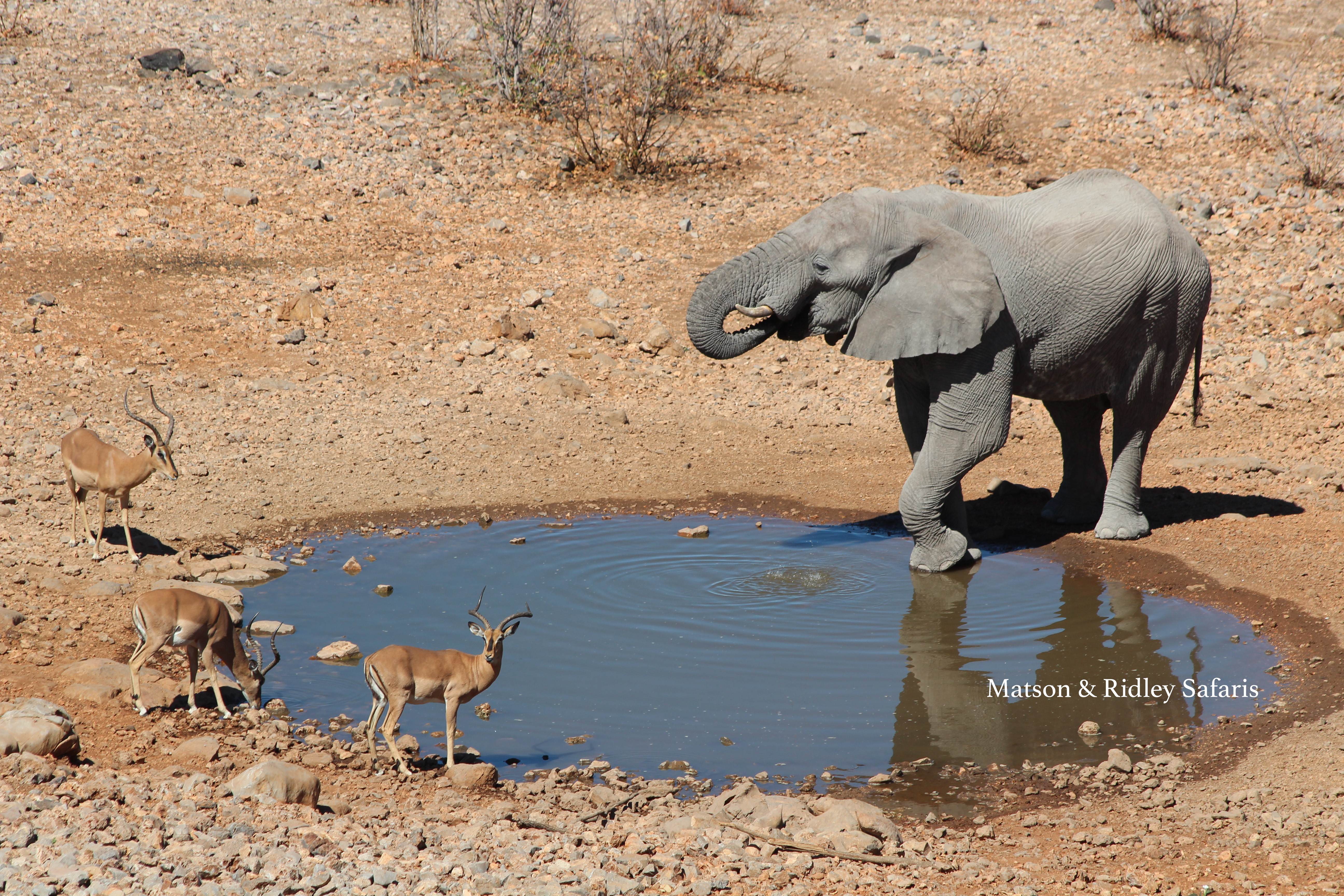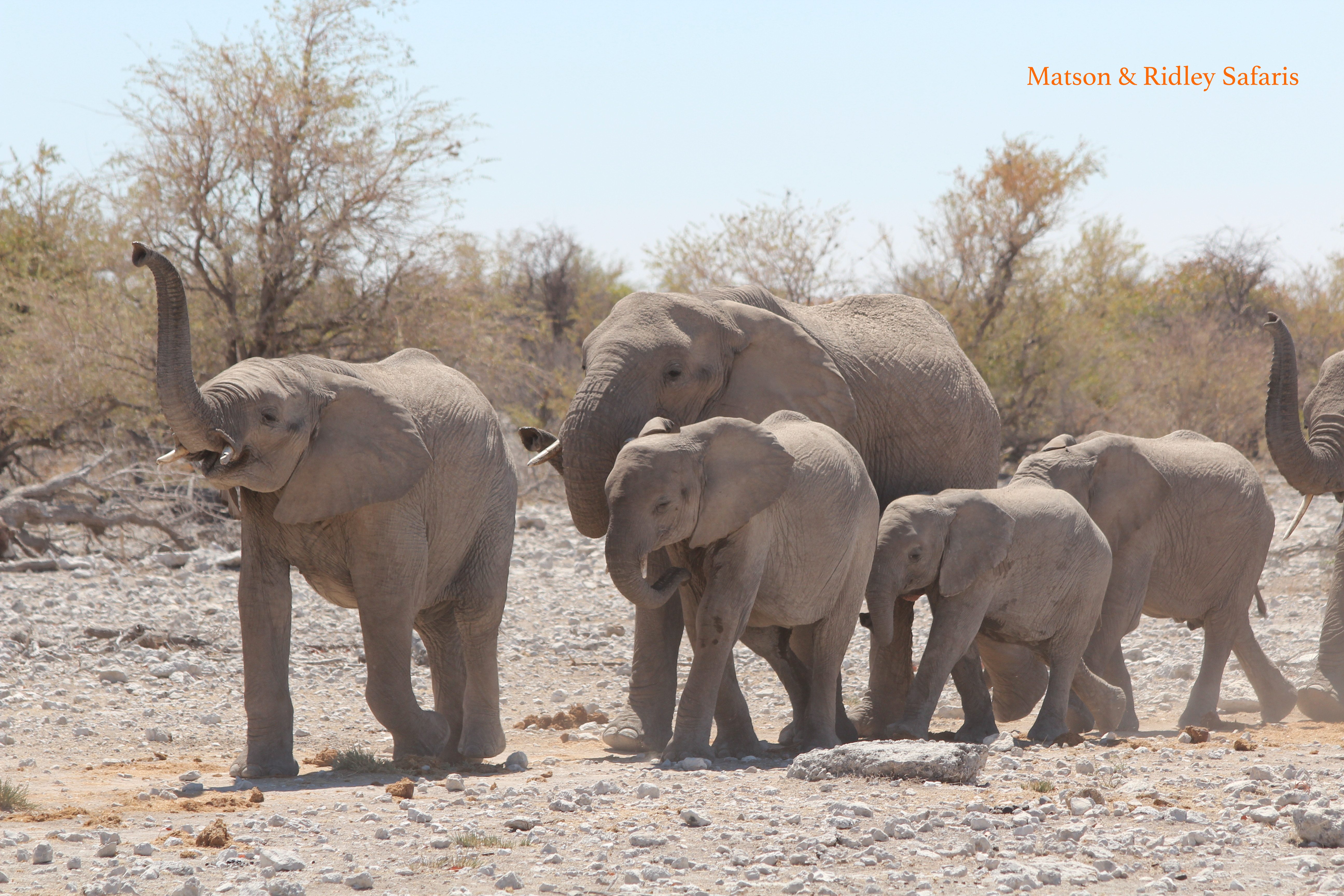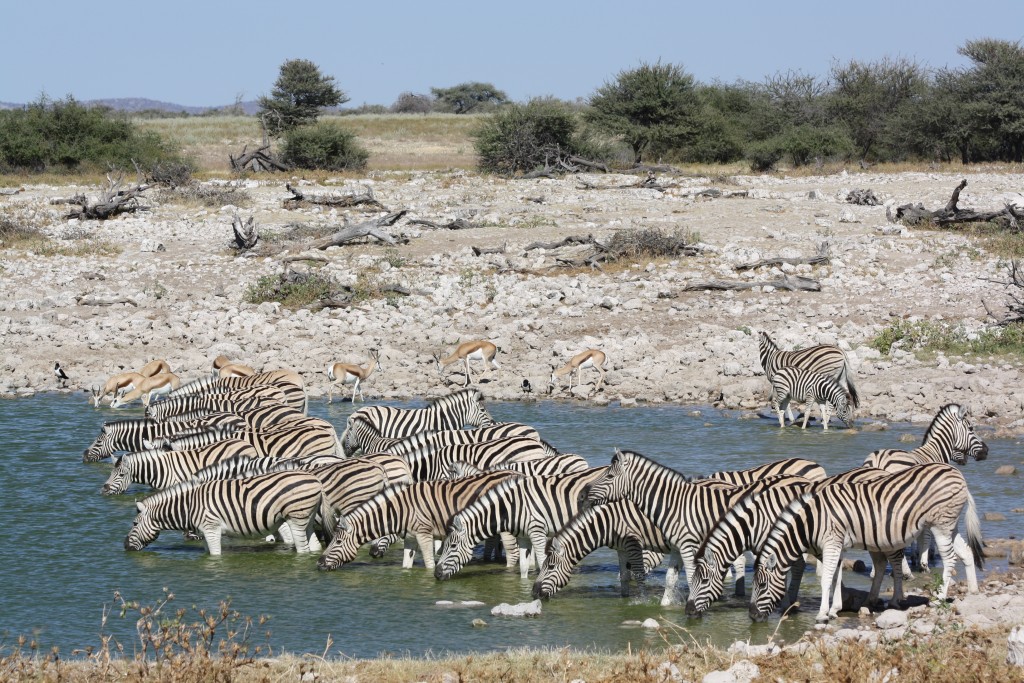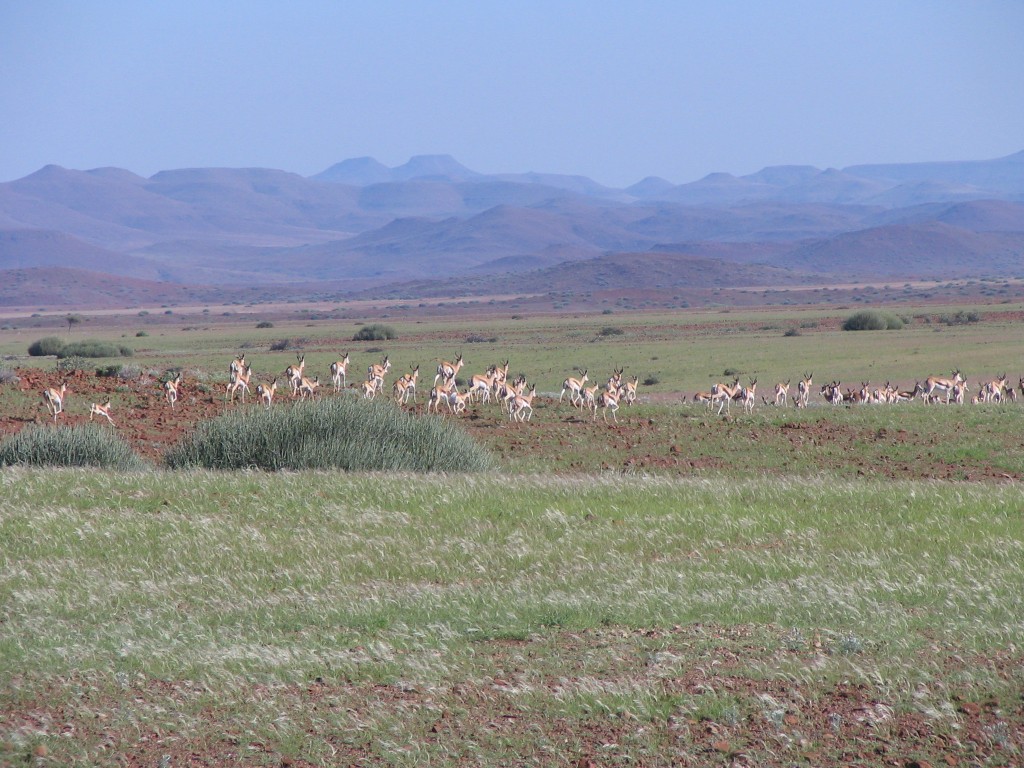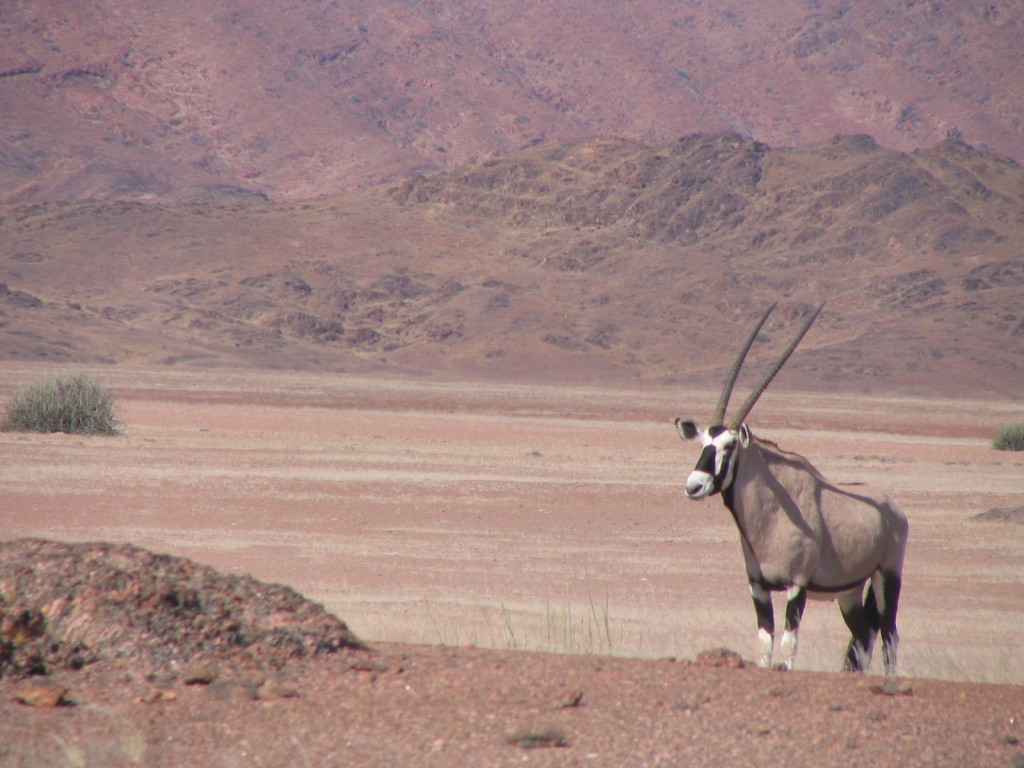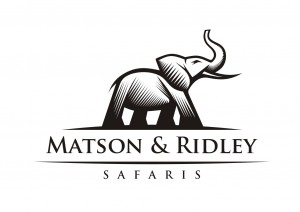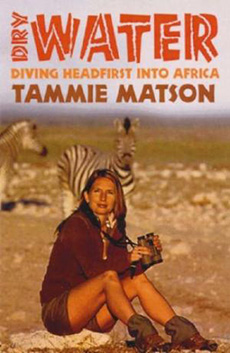Wow Moments from Namibia’s Wild North West
How does one summarise a week in Namibia’s rugged Kunene region, one of the wildest parts of Africa? It was just one wow moment after another! There was the cheetah mother with two cubs who killed a springbok male in the dry Hoanib River bed, the chameleon laying eggs at the Skeleton Coast, the drive through the dunes to the violent Atlantic Ocean where hundreds of seals frolicked in the crashing waves, meeting the traditional Himbas in Marienfluss Conservancy and of course, the desert lions (with cubs!) and desert-dwelling elephants…. And then there is those epic landscapes, so huge and awe-inspiring that you feel so small and incredibly humbled by it all.
It’s hard to sum up north west Namibia in one blog because it’s so much more than a holiday – it’s a life changing experience and a grand adventure! I think the photos tell the story so let’s start with that…. This week I’m sharing a few of my pictures from the Hoanib River and Skeleton Coast. Next week stay tuned for photos from Serra Cafema in the Marienfluss Conservancy, home to the Himba people. Hoanib Skeleton Coast Camp is a joint venture between Wilderness Safaris and local people in three conservancies, Sesfontein, Anabeb and Torra. Matson & Ridley Safaris also made a donation to the Giraffe Conservation Foundation from this safari. I want to thank Helen, Chuan Fong, Patricia, Maggie, Jo, Leonie, Tristan and Carina for being such intrepid desert adventurers and great company, and I really hope we meet again by the campfire soon.
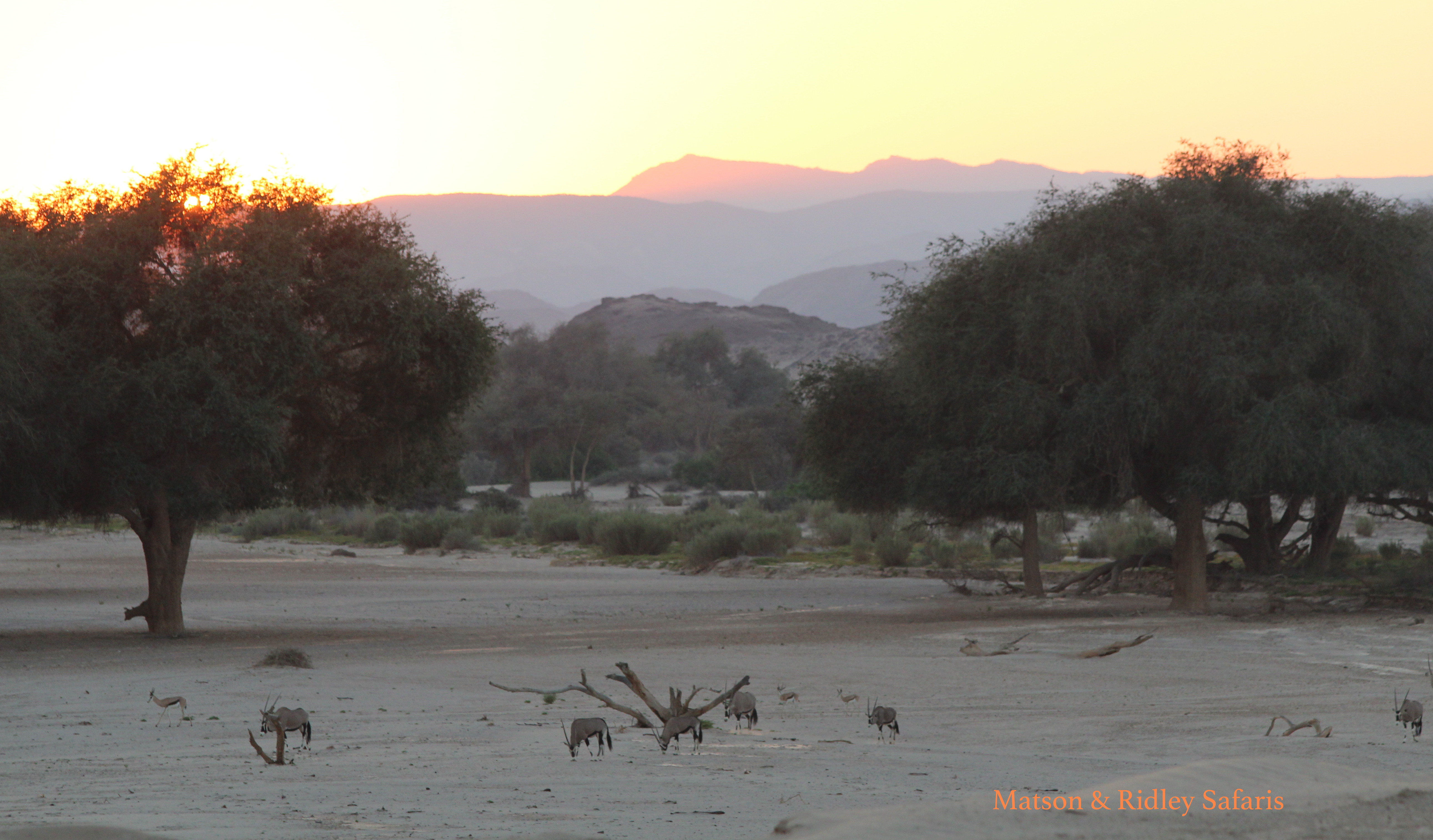
I love the dawn light in Namibia. There’s a short time where everything turns a rosey-apricot. Just before that time, all seems peaceful and cool, before the suns rays bear down on the desert sands. This photo of a herd of oryx was taken at sunrise in the Hoanib River. Just a few months earlier, this river had run, something very rarely seen in this neck of the woods. It had barely rained in camp, but there was more rain inland, enough to cause the river to run, and even a little rain makes a huge difference in arid landscapes.
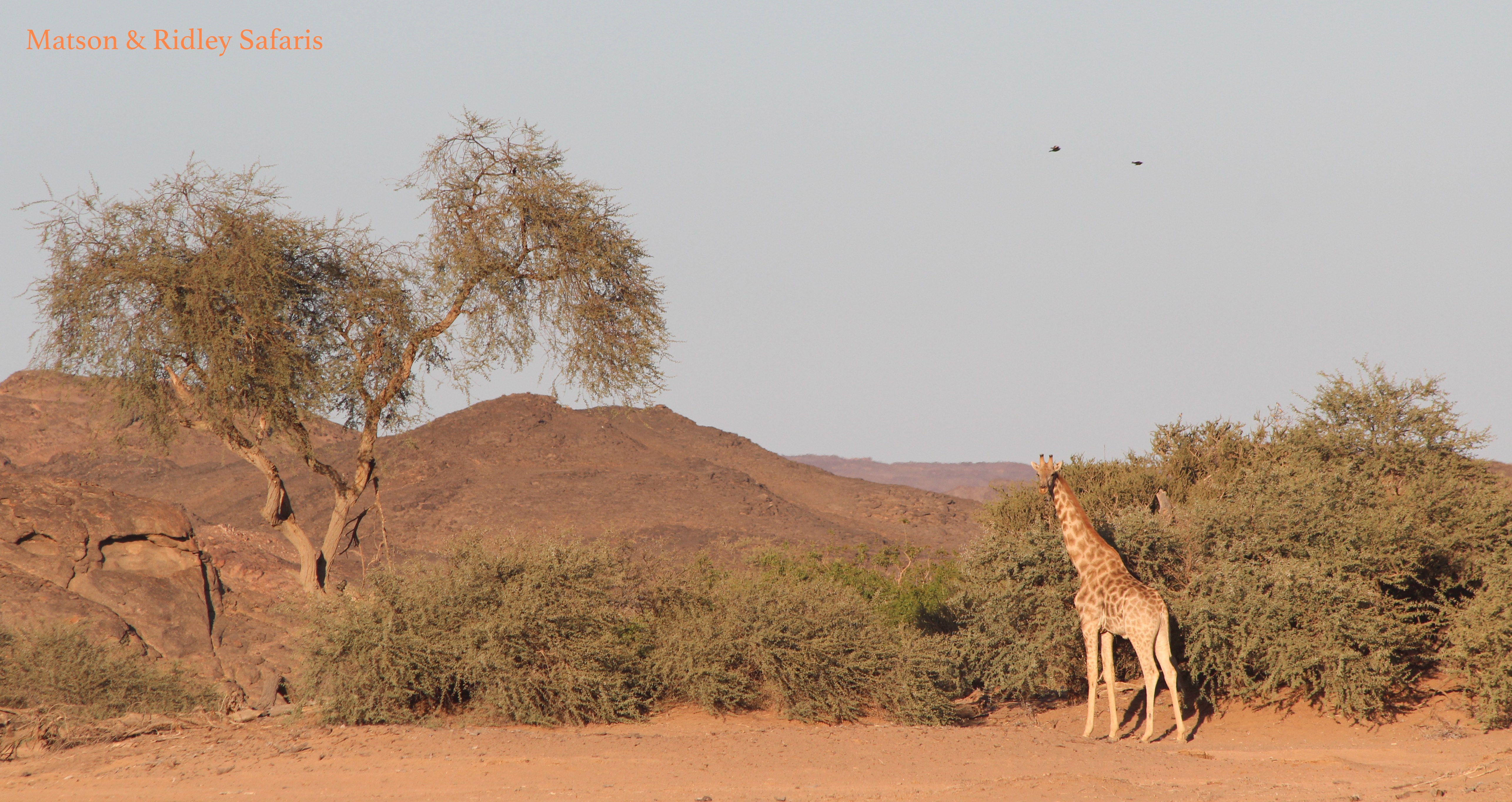
Desert-dwelling giraffes or desert lion-prey (depending on how you look at it!) are a frequently sighted species in the Hoanib River ecosystem. The tall, shady Ana trees (Faedherbia albida) that line the dry Hoanib River all bear browse lines at giraffe/elephant height and were providing a rich source of protein for many species with all their dropping pods when we were there. When you first arrive at Hoanib it’s like you’ve landed on the moon. You wonder how could anything live here with so little food and water? And then you go down into the river and you realise just how much life is there, and what amazing adaptations the animals and plants have to living in this hostile, arid environment. Our group loved hearing more about desert-dwelling giraffes from Dr Julian Fennessy on our last night on safari, and you can support the work of the Giraffe Conservation Foundation, one of the projects we at Matson & Ridley Safaris support, by checking out their website. And don’t forget 21 June is World Giraffe Day!
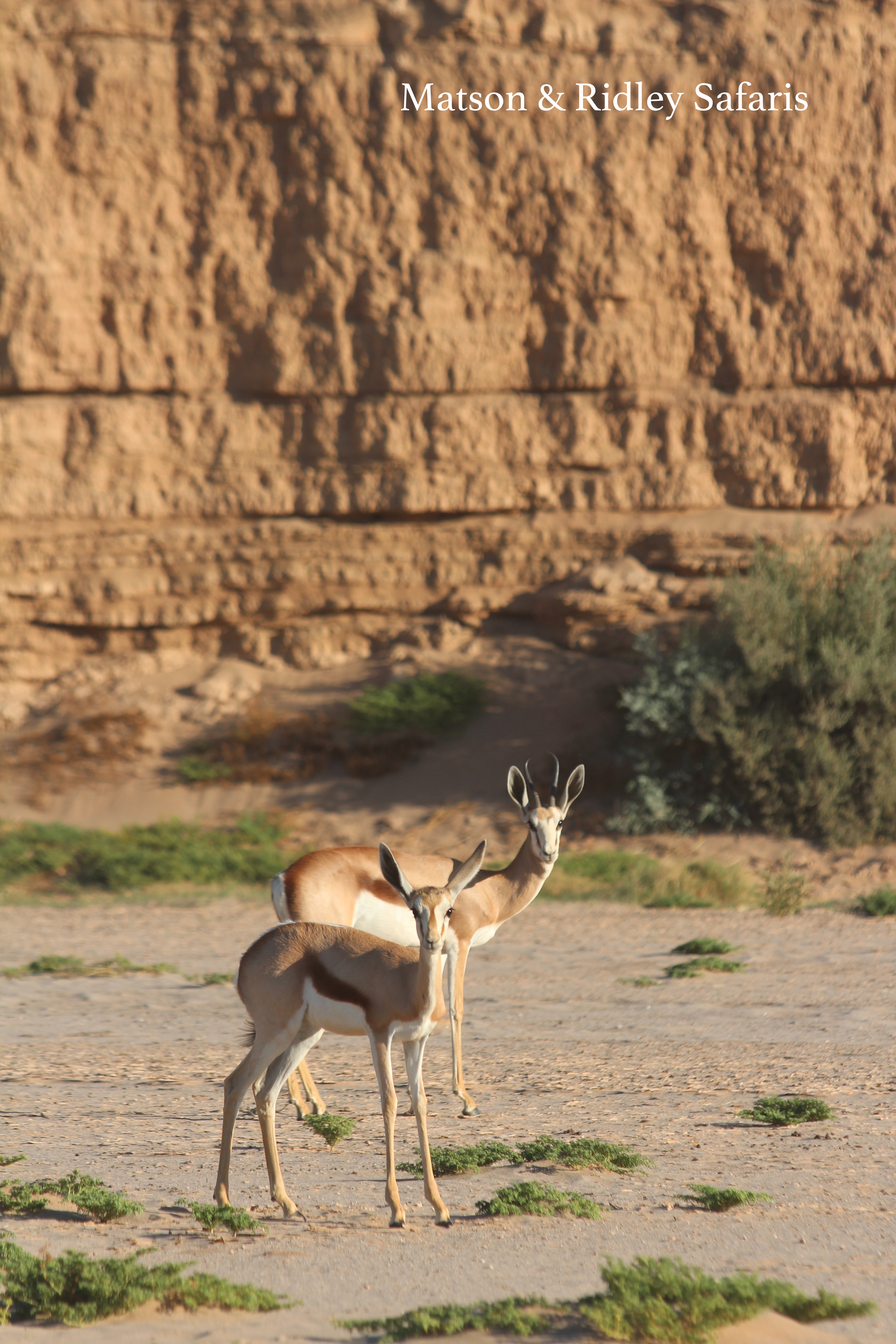
Springboks feast on freshly fallen pods of Acacia and Ana trees in the Hoanib River, as well as the water-filled ‘ostrich salad’ (seen here in the foreground). When the fog rolls in from the Atlantic Ocean about 60 km to the west, this replenishes the succulent plants that they eat, and so springbok rarely need to drink as they get enough water from their food. Unfortunately during our time at Hoanib the infamous ‘east wind’ prevailed on the coast, bringing very hot winds from the inland, preventing the fog rolling in from the ocean, and bringing temperatures up to almost 40 degrees Celcius in the sun. You can never predict the weather in this country! It was a fresh reminder to me that you always have to prepare for possible extreme heat and extreme cold in the desert.
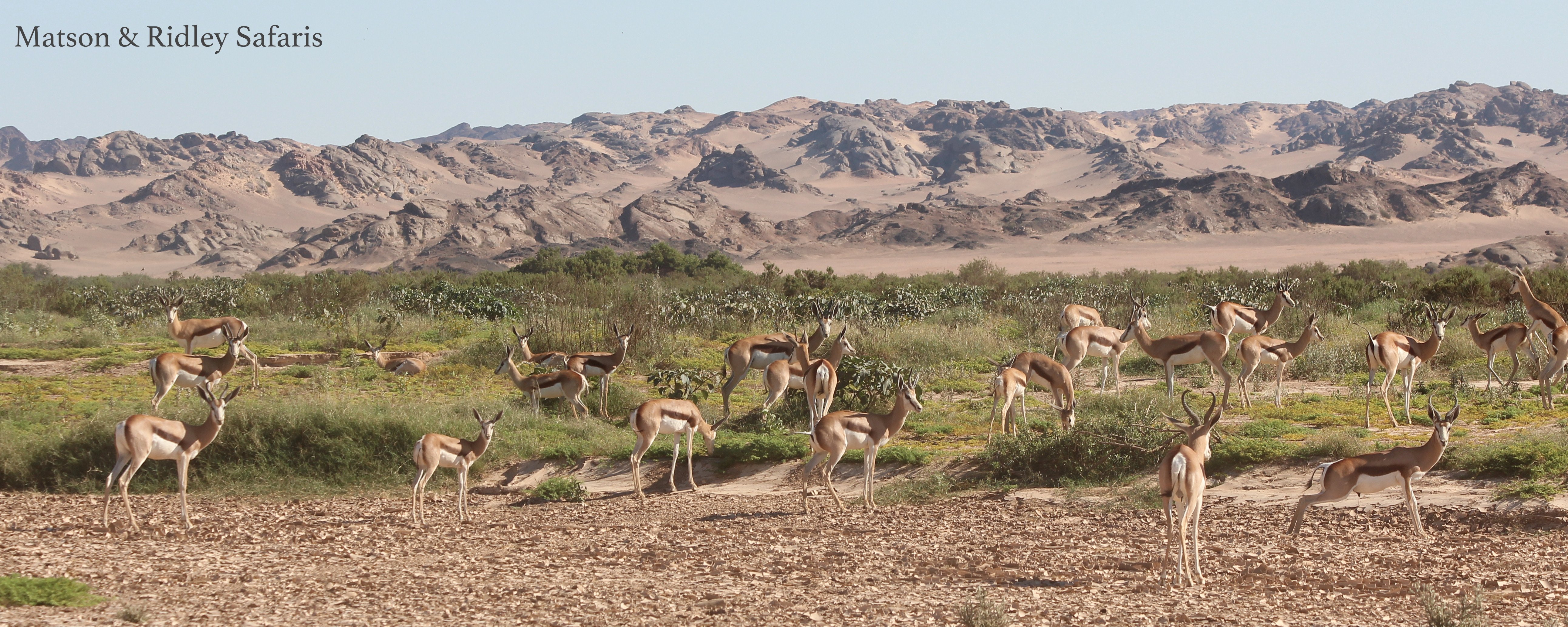
Springboks enjoying the green pickings while it lasts at the floodplain at the end of the Hoanib River near the Atlantic Ocean. Springbok are so well camouflaged in the desert and their white under belly allows heat to be deflected off the oven-hot ground as the day warms up.
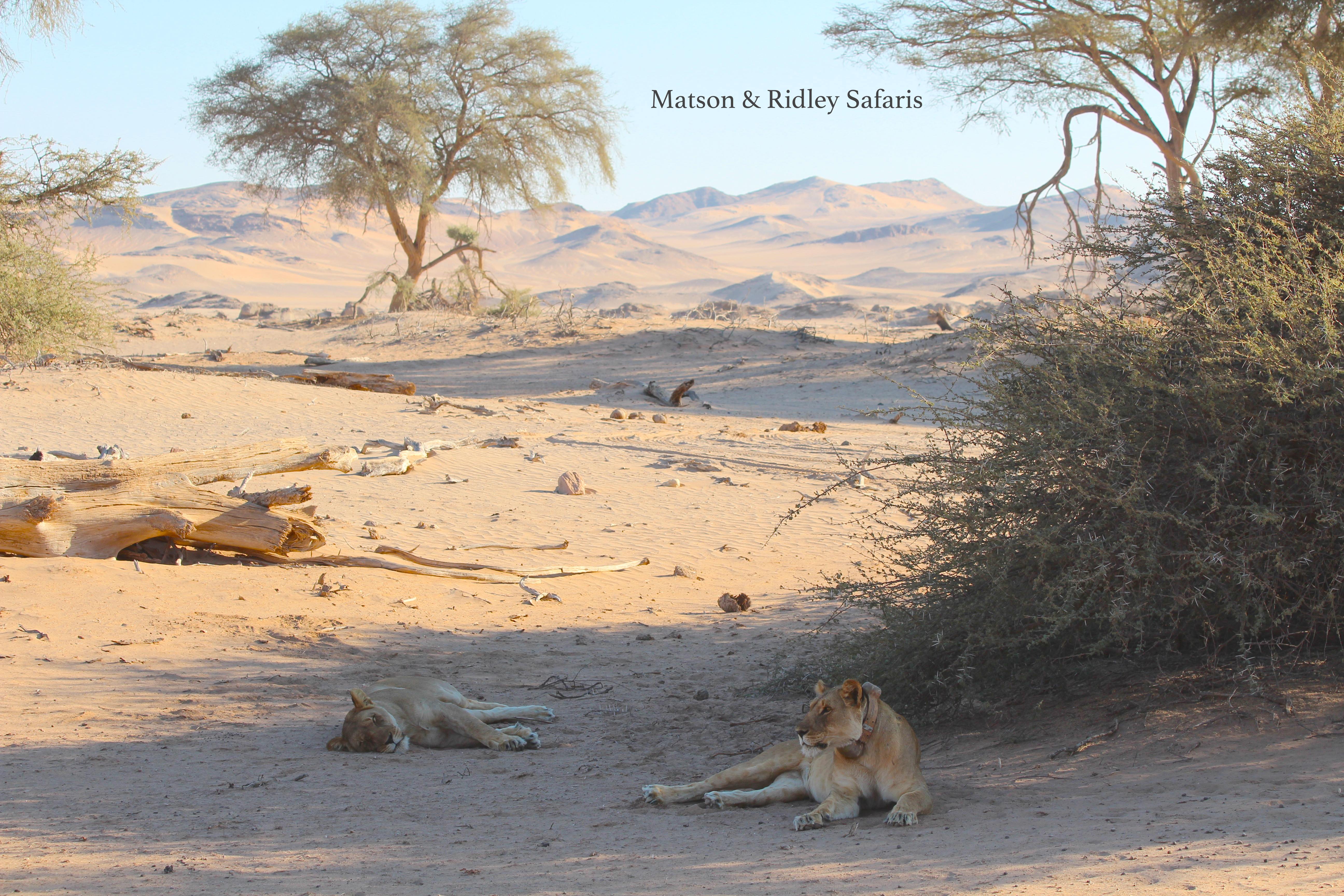
Just a few hours in to our drive to the Skeleton Coast, our Wilderness Safaris guides Elias and Liberty spotted fresh lion tracks. Searching for them on both sides of the river, following their tracks, we eventually found the two lionesses and 3 young cubs, lazing in the shade. The two lionesses are stars in the brilliant new National Geographic documentary, “Vanishing Kings“, and these incredible desert mamas provide for themselves and their offspring in formidable, harsh conditions. These lions are specialised giraffe hunters, no mean feat for just two of them. For a while there they were also feeding their 5 almost grown up sons! The desert-dwelling lions in this area are part of a long term study by lion expert Dr Philip Stander. They have huge home ranges and often must walk a very long way to find food in these arid conditions.
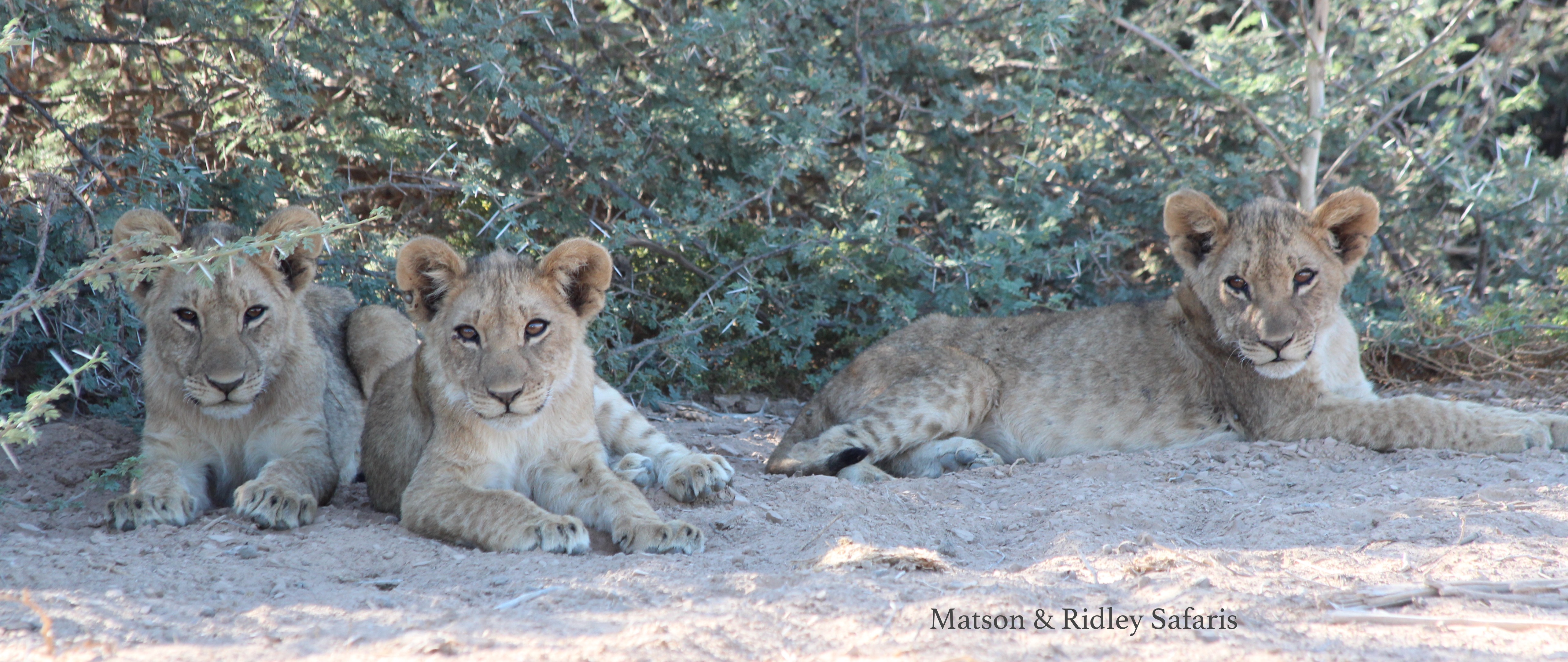
The next generation of desert-dwelling lions is crucial to the survival of this population. Desert-adapted lions often move out of protected areas and come into contact with people and their livestock in rural areas, creating obvious conflicts with local people who consider their cows to be the equivalent of money and status. They can be shot or poisoned by farmers who do not want them threatening their cattle. While we were there, the ‘five musketeers’ (the 5 lions who are the offspring of these two females, now fully grown) had wandered up to Purros Conservancy and out of the safety of the park, creating concerns among the staff at Hoanib Camp. We wondered what the future held for these 3 small female cubs. A fourth cub, their sibling, had been washed away in the January flood. At least with the two lionesses teaching them how to survive, they have great examples to follow.
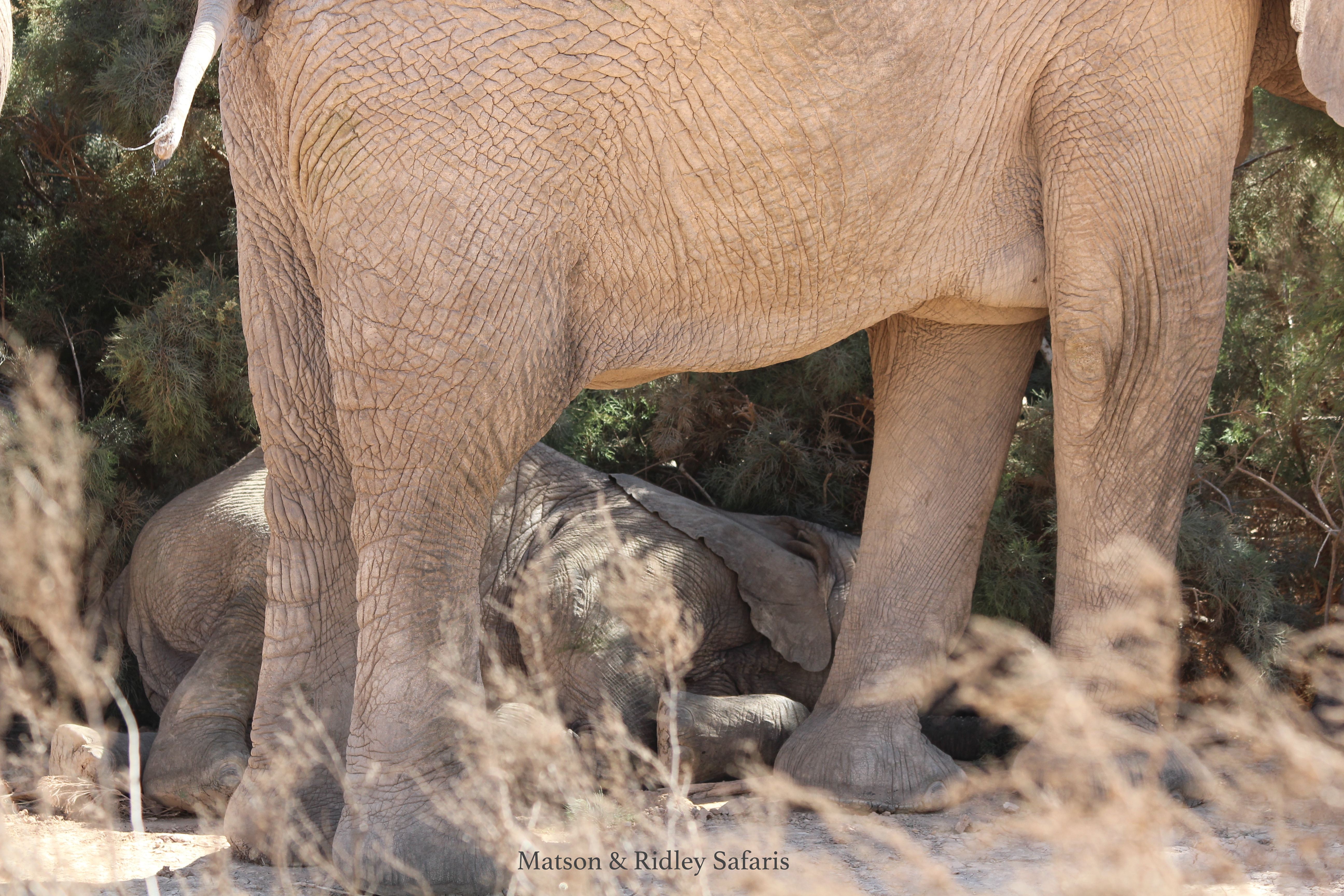
When a baby elephant lies down beside its mother right beside you, you know it’s feeling pretty relaxed. It’s a privilege to see this. In other parts of Africa, elephants can never relax due to the presence of poachers for the ivory trade. This herd of desert-dwelling elephants move up and down the Hoanib River, feeding on the Ana trees and other shrubs along the length of the sand river. We all enjoyed the ‘elley-therapy’! Note the wide feet of the desert-adapted elephants, suited to sliding down sand dunes and walking on sand over long distances.
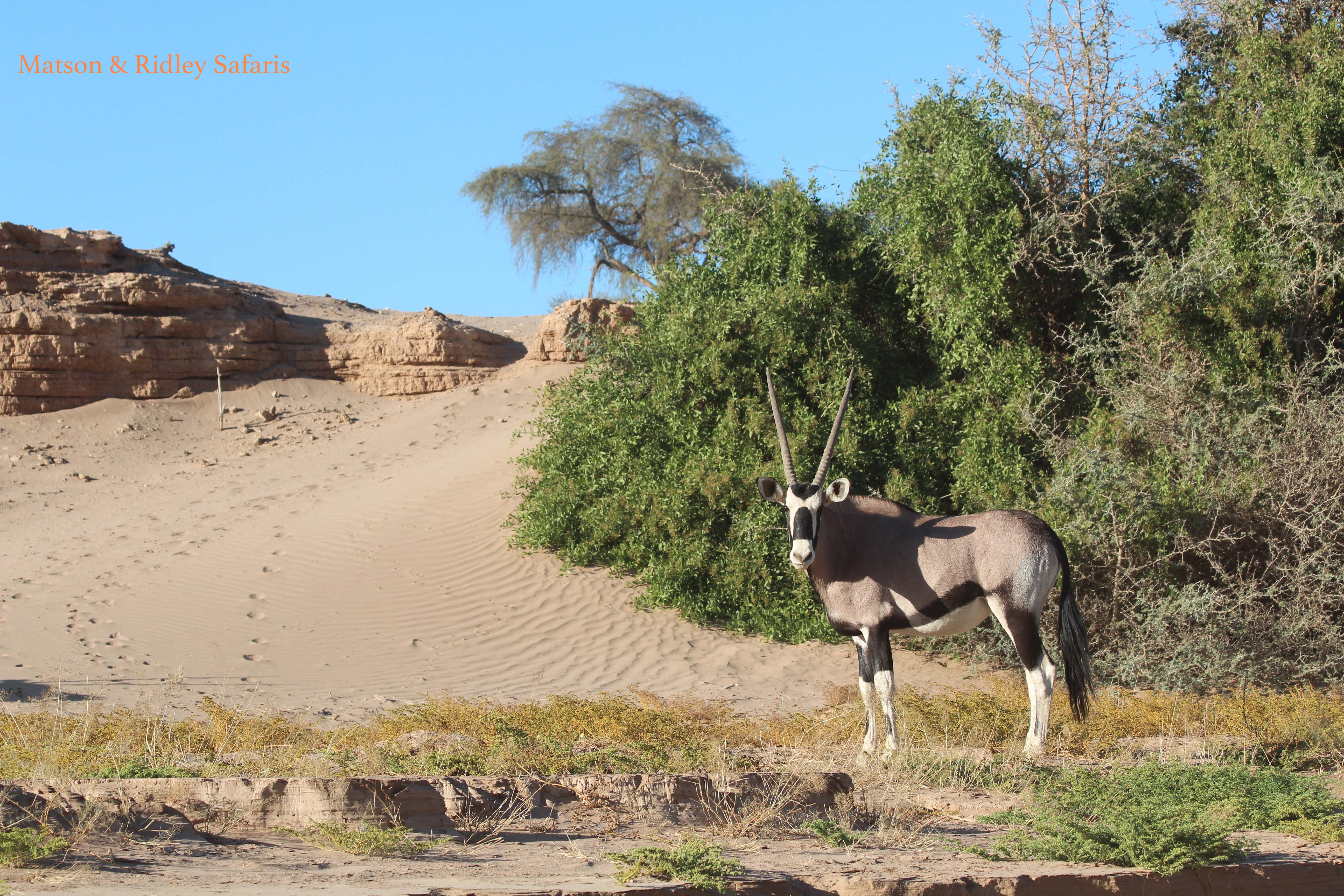
Oryx antelope – one of the most regal of all the antelopes, and the perfect desert survivor. Note the white underbelly and white on the lower legs for reflecting heat. The oryx practices nasal panting, which prevents the brain from overheating when standing in the desert sun at extreme temperatures. Like the springbok, they barely ever need to drink, gaining enough water from their food.
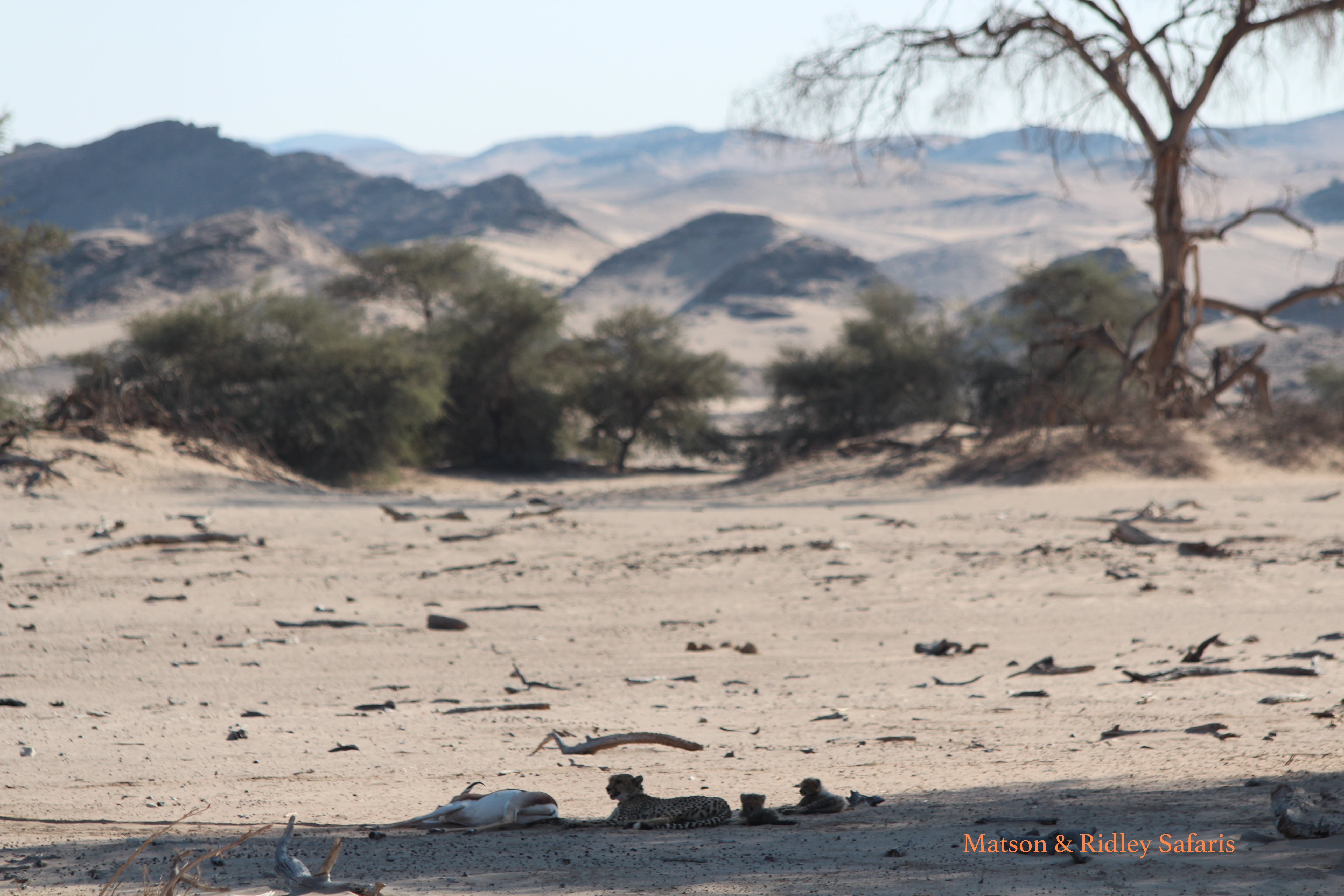
This is something you don’t see every day! The photo isn’t the greatest but this was a rare sighting indeed. It started with our guide Elias spotting fresh cheetah tracks in the sand, but you could tell there were predators around as there wasn’t much game around this area. Then Leonie spotted her – a cheetah mother with small cubs! We kept our distance, giving her space, as with young cubs she was more wary and we didn’t want to spook her. And then as we patiently sat there, she crouched down and became very interested in something in the river. It was a male springbok. Well now things were about to get interesting. It’s one thing to see a cheetah in this environment, but quite another to see one kill a springbok, with two cubs running along behind her! It took the female almost half an hour to cool down after making the kill and dragging it into the shade. The two cubs were impatient to eat, tugging on the ears of the springbok and trying to open it up (without success!).
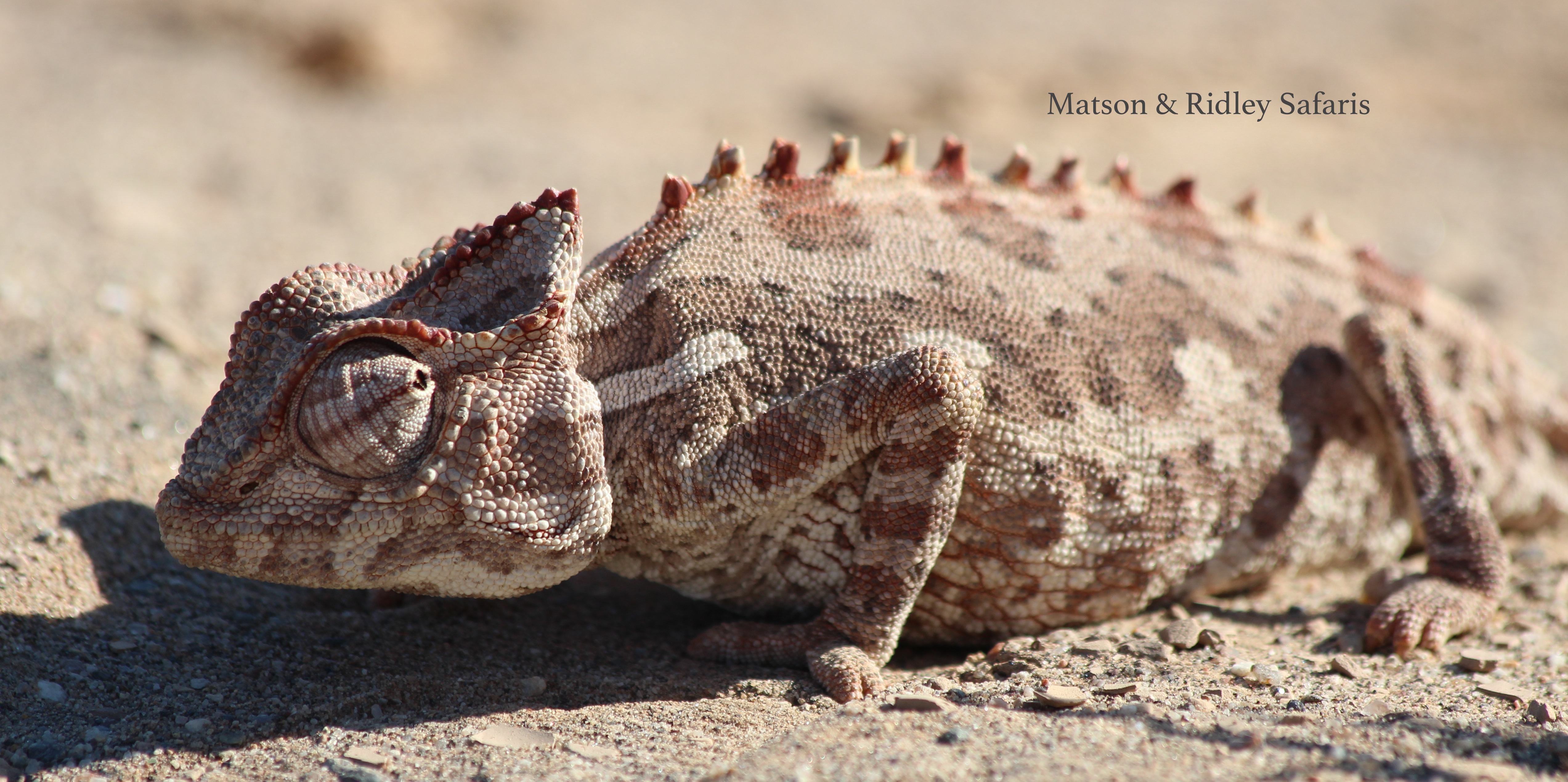
If I didn’t know better, I’d never have known this chameleon was heavily pregnant with eggs, but you can see from the size of her belly. She was on the road, and our guides kindly surrounded her with big logs to stop other guides driving over the top of her. Below you can see the eggs she had just laid, something I had never seen before. In fact until this day I never even thought about how baby chameleons arrive in the world, so now we know!
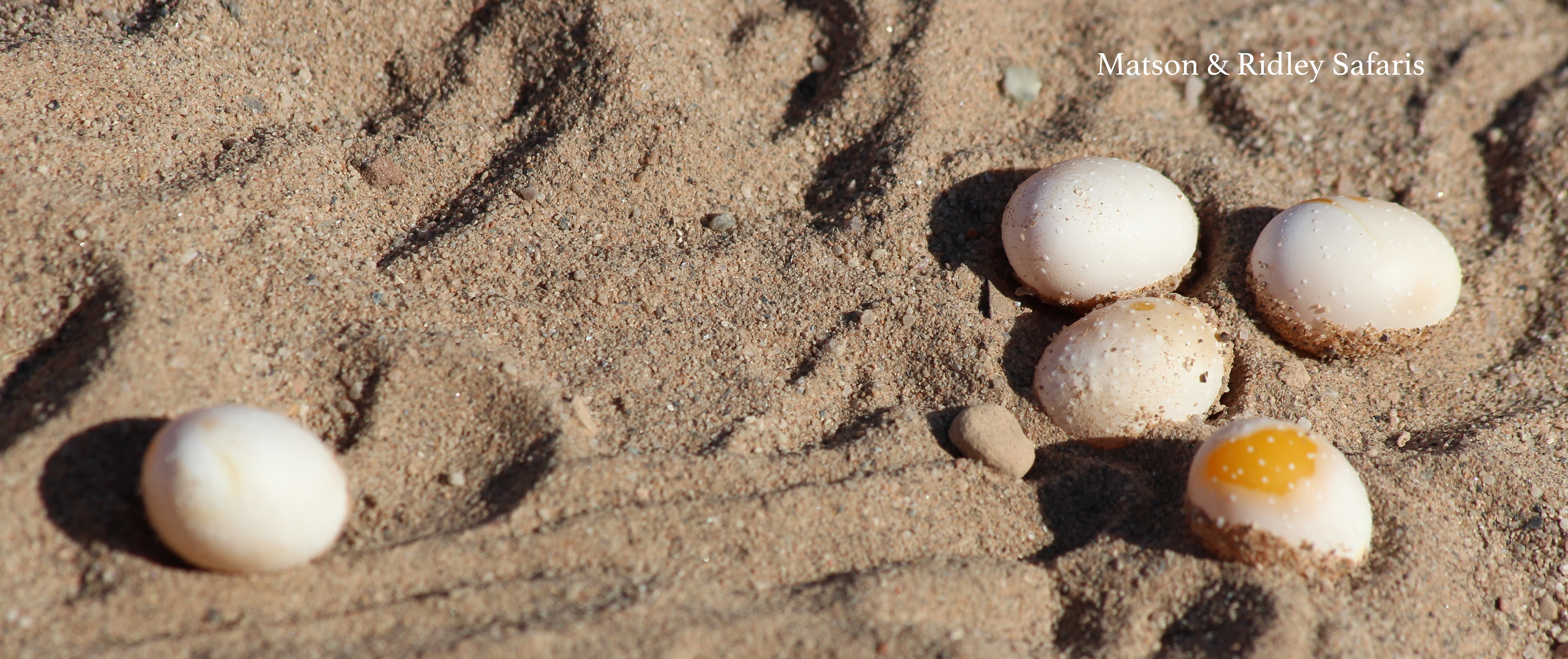
Eggs of said chameleon above. The guides told us she would bury these once we left her alone. What a thrill to witness this!
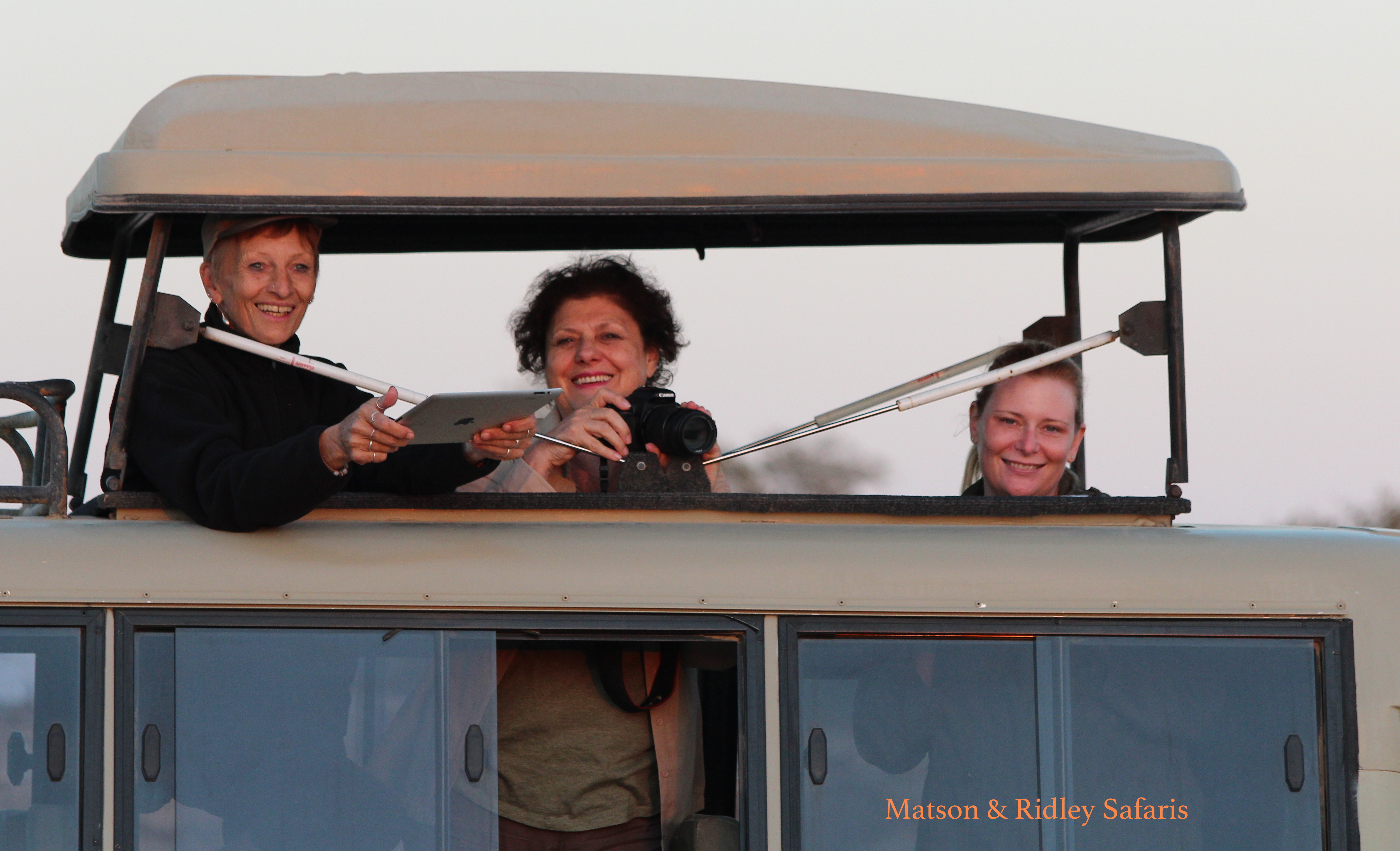
Maggie, Leonie and Joanne, ‘the Aussies’, watching the sun rise in the Wilderness Safaris land cruiser. We had everything from Canon and Nikon SLRs to iPhones and iPads in our collection on this trip. Helen brought along a new 600mm lens for her Canon SLR which really gave a good view of the wildlife, especially the kills. I had my 100-300mm Canon SLR which I used for all of these photos. I’m looking forward to seeing everyone else’s best shots. Post them on our Matson & Ridley Safaris Facebook site if you like!

On an afternoon walk, I opened up a ball of elephant dung that was still wet inside and discovered fresh seedlings of Ana trees. I often talk about how elephants distribute seeds through their dung and it was very cool to see the seedlings literally germinating inside this dung. Elephants are keystone species and the whole ecosystem depends on them.
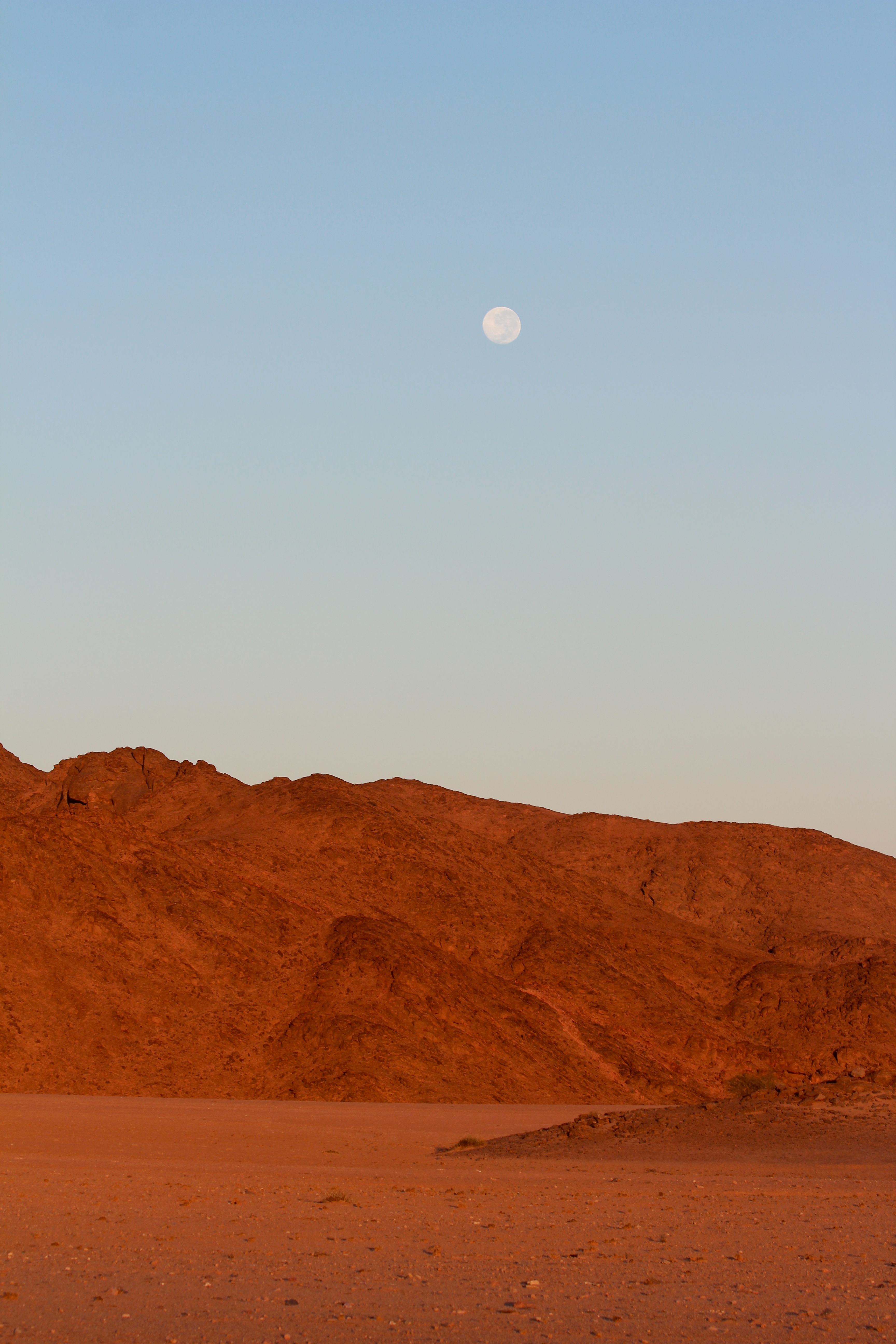
Dawn light is so amazing in the desert, although fleeting, and the full moon while we were there made for a really striking sight. A big ‘awww’ moment! It’s the landscapes and the space that make Namibia so amazing. It’s a place to leave your mobile phone behind and just reconnect with nature and yourself.
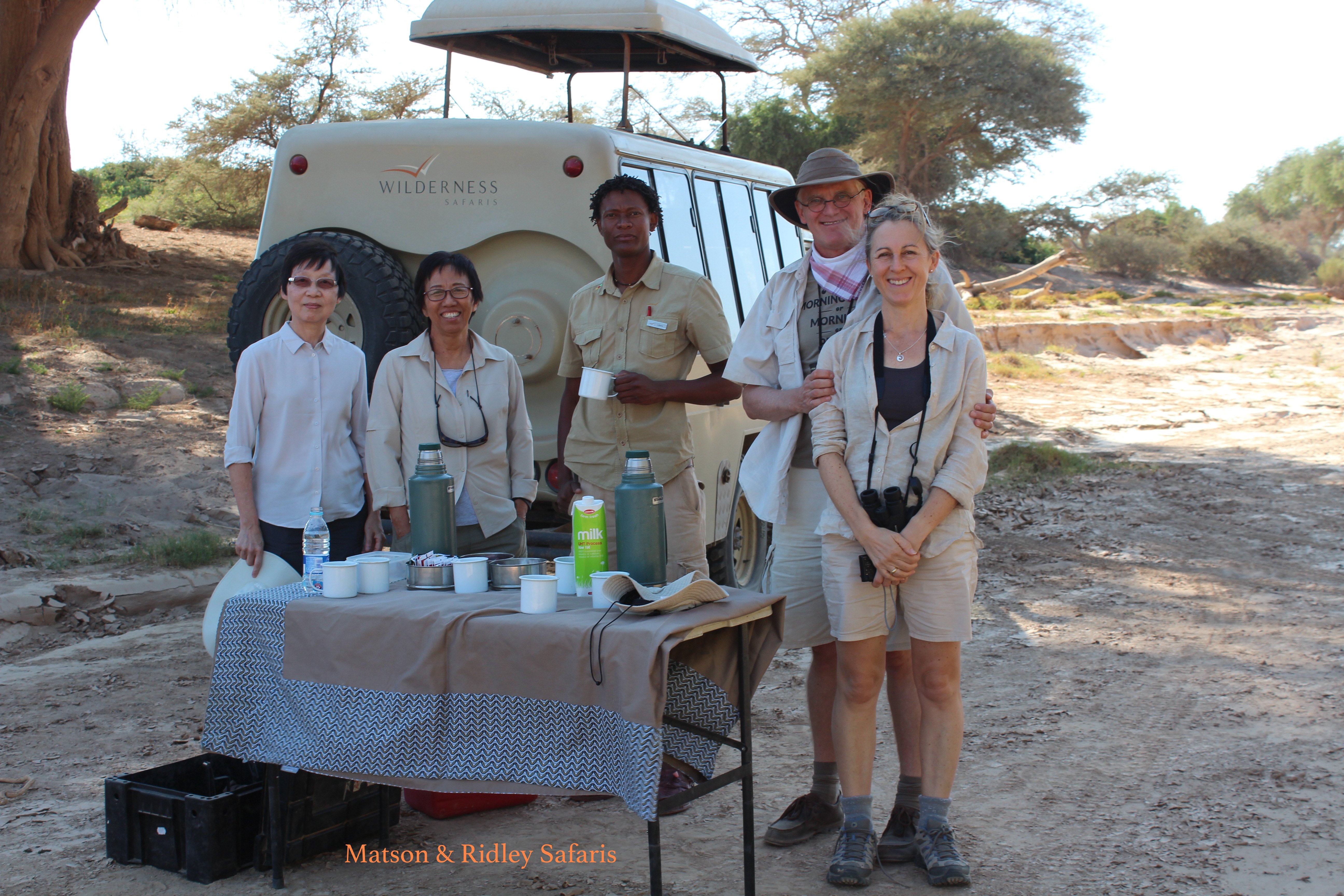
Tea time in the bush is always welcome. By mid morning, when you’ve been on a game drive since dawn, it’s definitely time for a cup of Five Roses South African tea and a home made biscuit, as well as a trip to the bush loo (after a quick check for puff adders and western barred spitting cobras). Here we pulled up in the Hoanib River bed, making sure that we were far enough away from the lionesses! Left to right: Patricia, Chuan Fong, Liberty, Tristan and Carina.
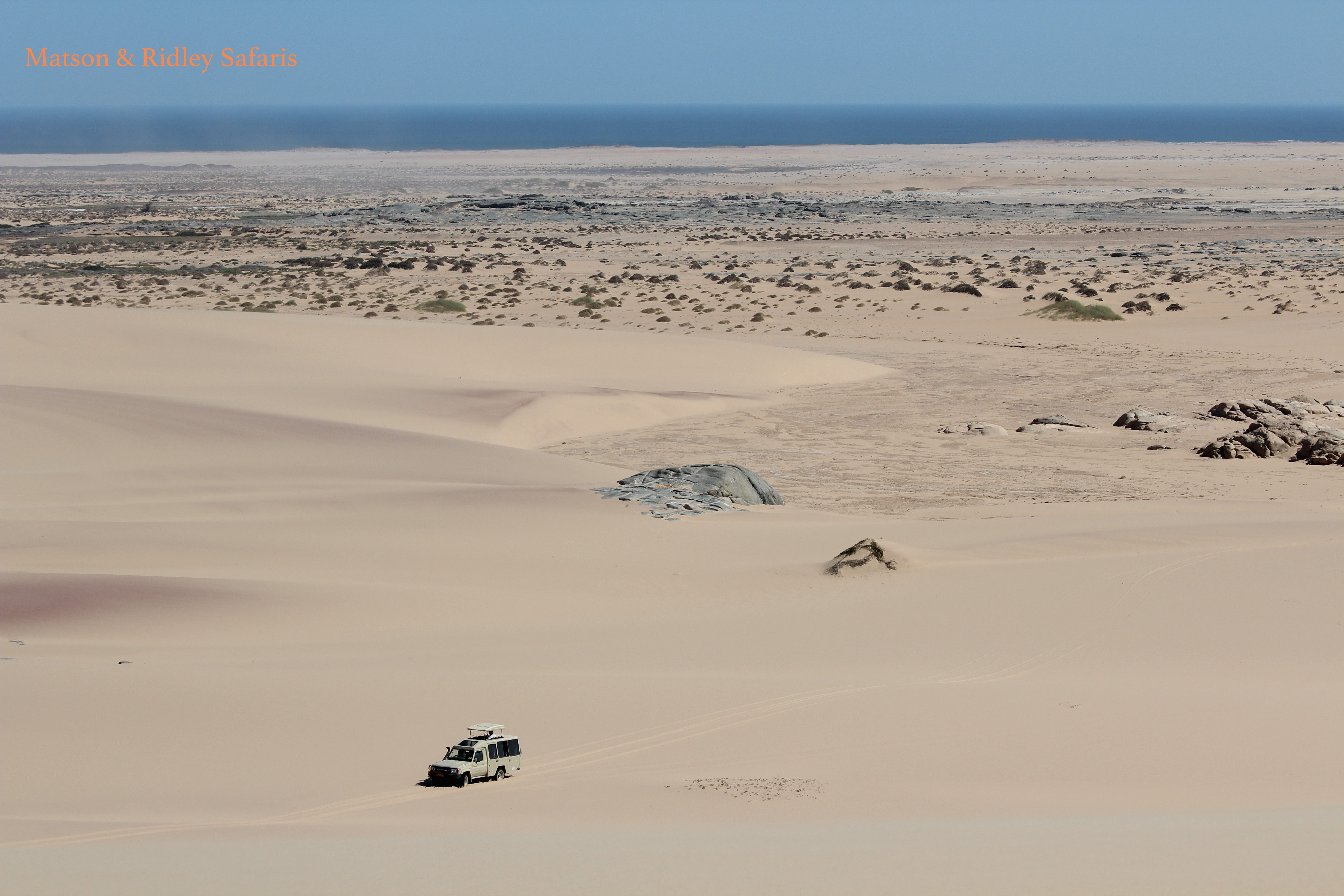
That first sight of the Atlantic Ocean in the distance as you cruise through the dunes through the Skeleton Coast is breath taking! This fragile ecosystem survives due to the fog, which creates moisture in an otherwise arid ecosystem.
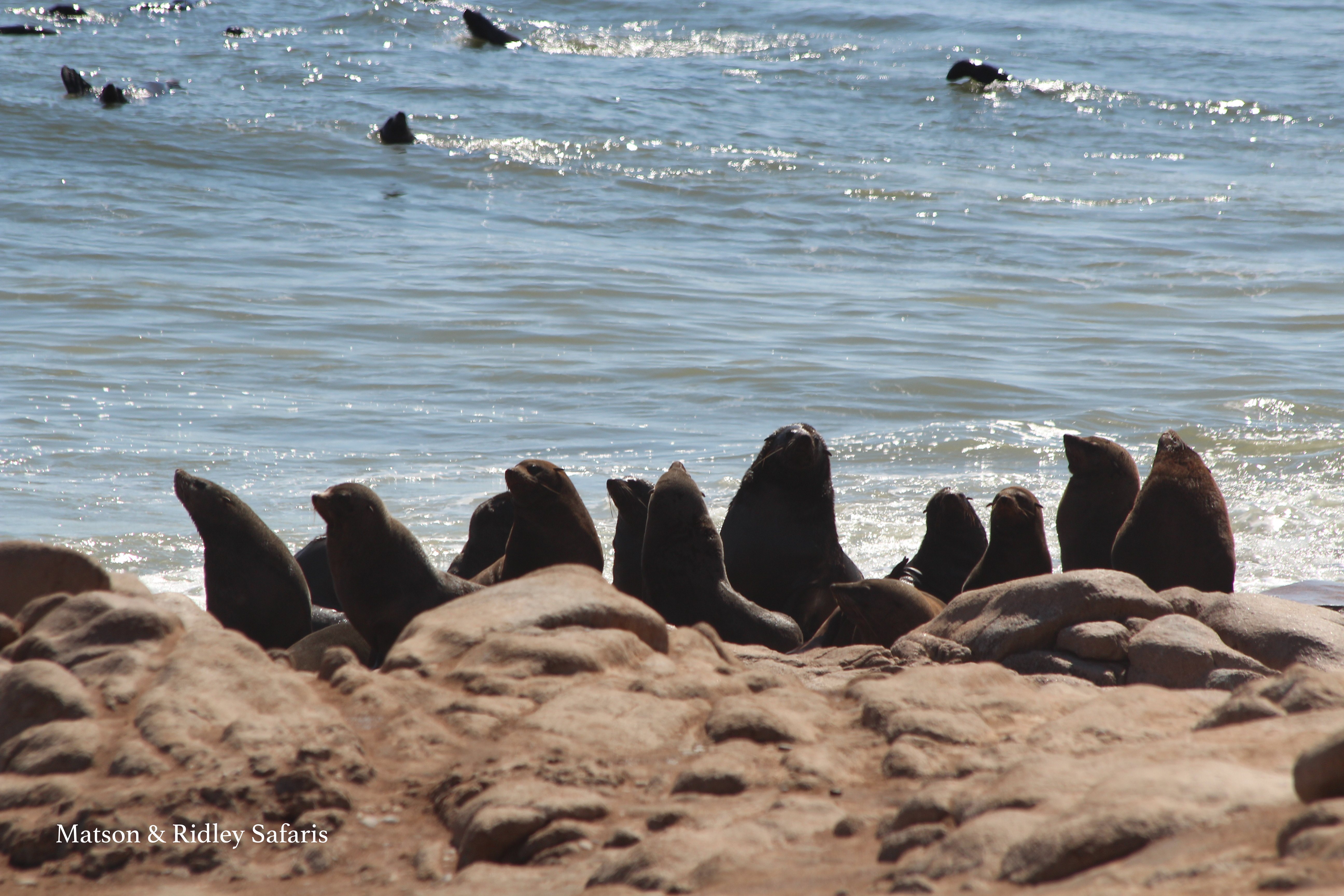
Cape Fur Seals form large colonies along the Skeleton Coast line and provide food for brown hyaenas and jackals (and sometimes lions). Lots of them were in the water on the day we visited, due to the East wind making it so hot on land. This photo was taken just near Merwe Bay.
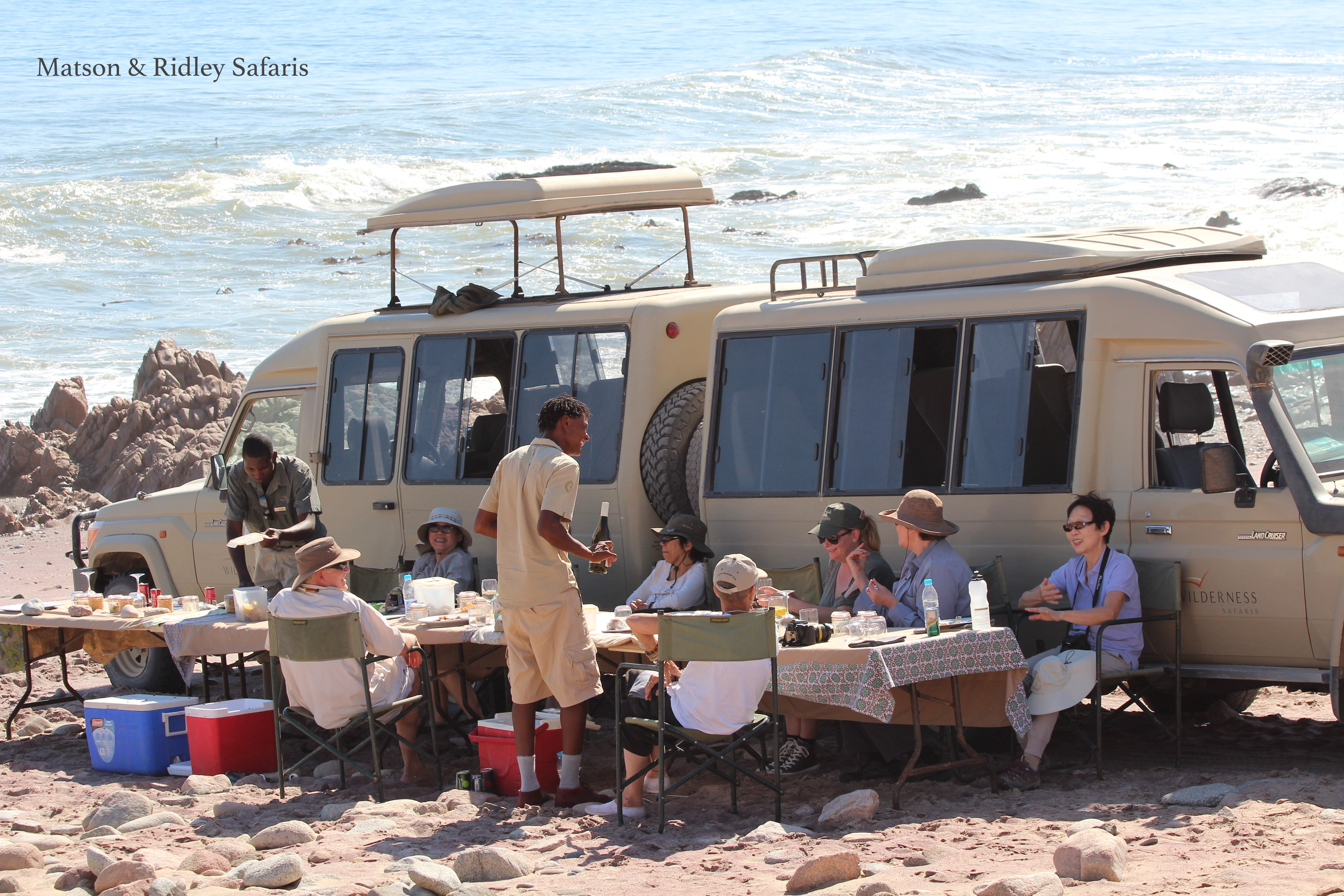
A much needed bit of shade beside the Land Cruisers was taken advantage of during a desert lunch and a wee drop of some fine wines.
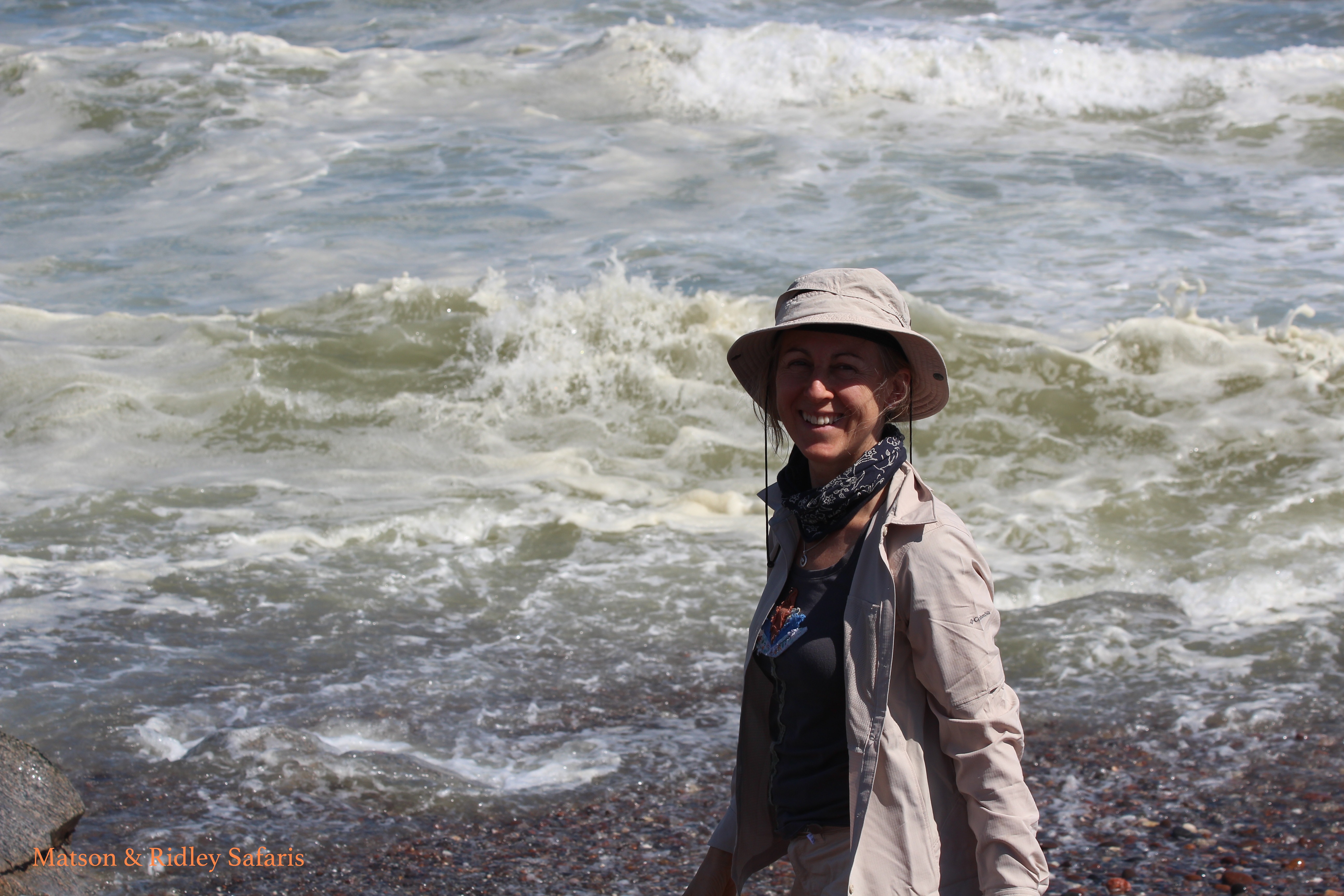
Carina by the sea…. The energy you get when hitting the sea after a long drive through the dunes is something else!
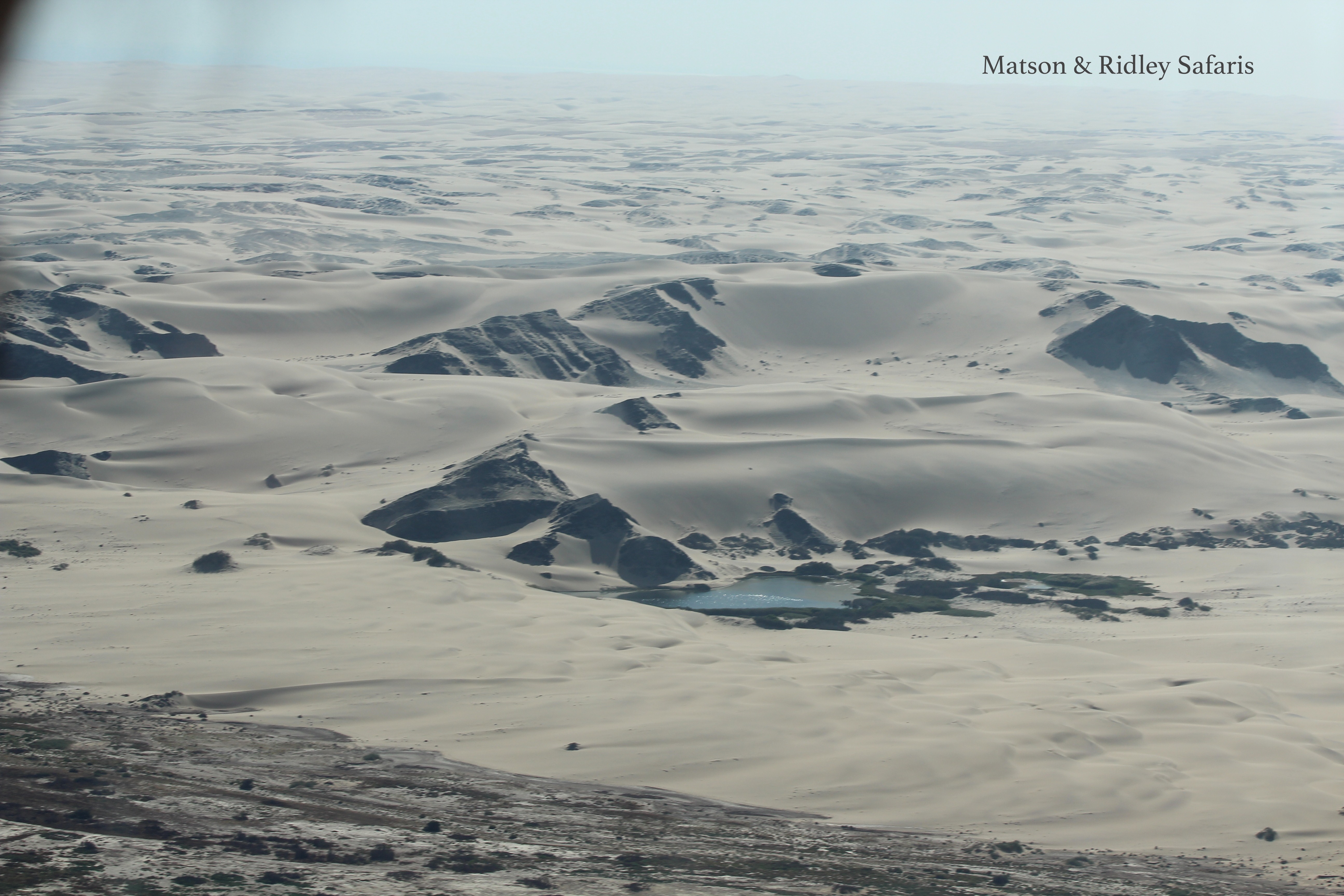
Something you rarely see – water in the desert dunes! This photo was taken from the plane on the ride back to Hoanib Camp. After the flood in January, there are still some waterholes left, creating amazing desert oases at the Skeleton Coast. This water will deplete and it could be another 5 years before the Hoanib sees another water flow.
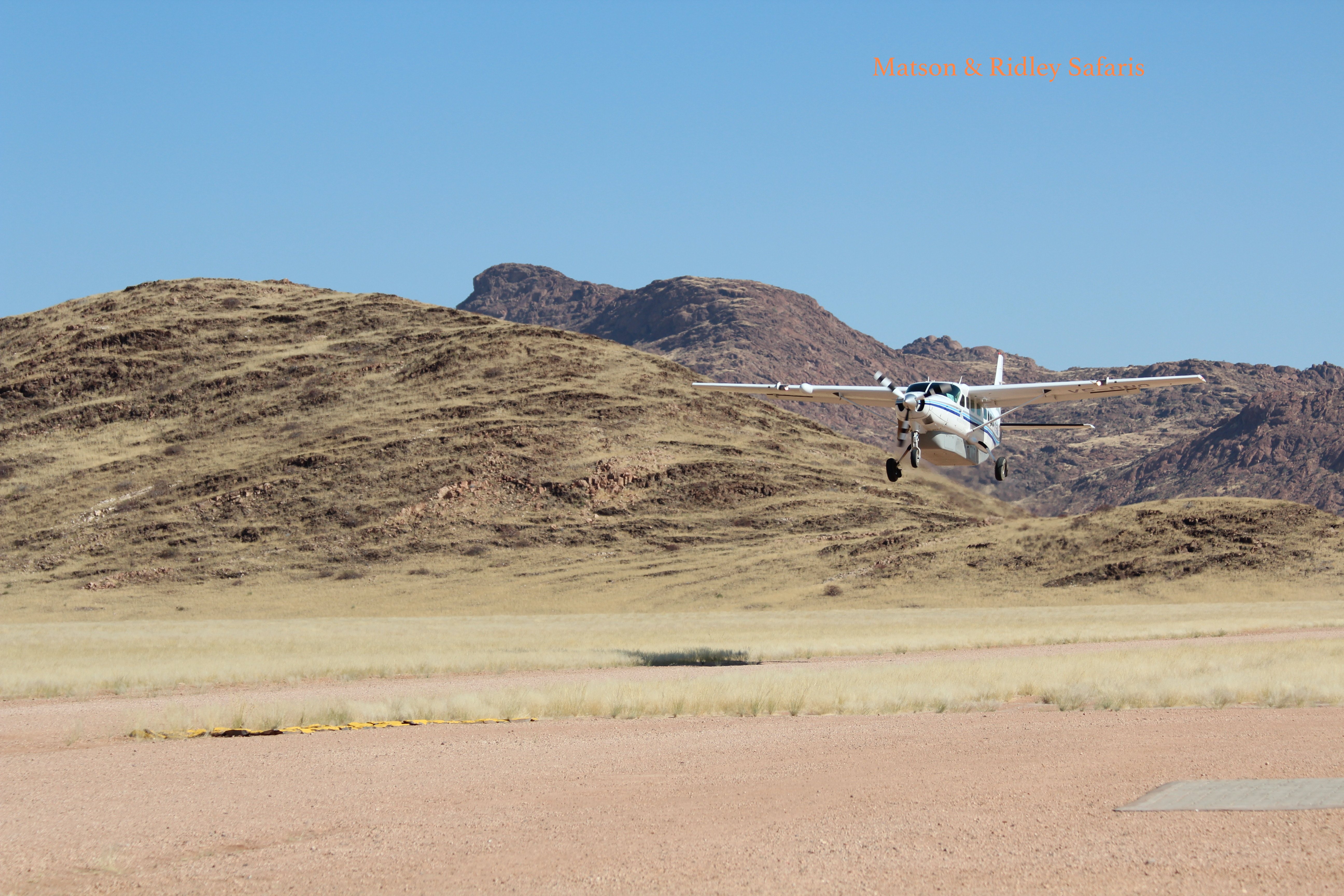
After 3 days at Hoanib Camp we set off for Serra Cafema, an hour’s flight north on the border of Angola. I’ll be blogging out it, with some incredible photos of this region and its traditional people, next week. Here’s a sneak peak, below…. And more photos coming at our Facebook page, so please like us at Matson & Ridley Safaris on Facebook to see them.
Namibia: the land God created in anger
It had been a few years since I’d been back to Namibia, the desert land where I studied black-faced impalas for my PhD, later planning a reintroduction for the subspecies to their historic range in the far north west. Namibia is also where I went on to start my work on elephants, working with the San Bushmen in Nyae Nyae Conservancy to help alleviate human-elephant conflict over water. Namibia will always have a special place in my heart, and it gave me a great grounding in the how-to of practical conservation. It’s also a great place to go on safari, being easy and safe by African standards, and having the most astounding landscapes, fascinating cultures and unique wildlife, unlike anywhere else.
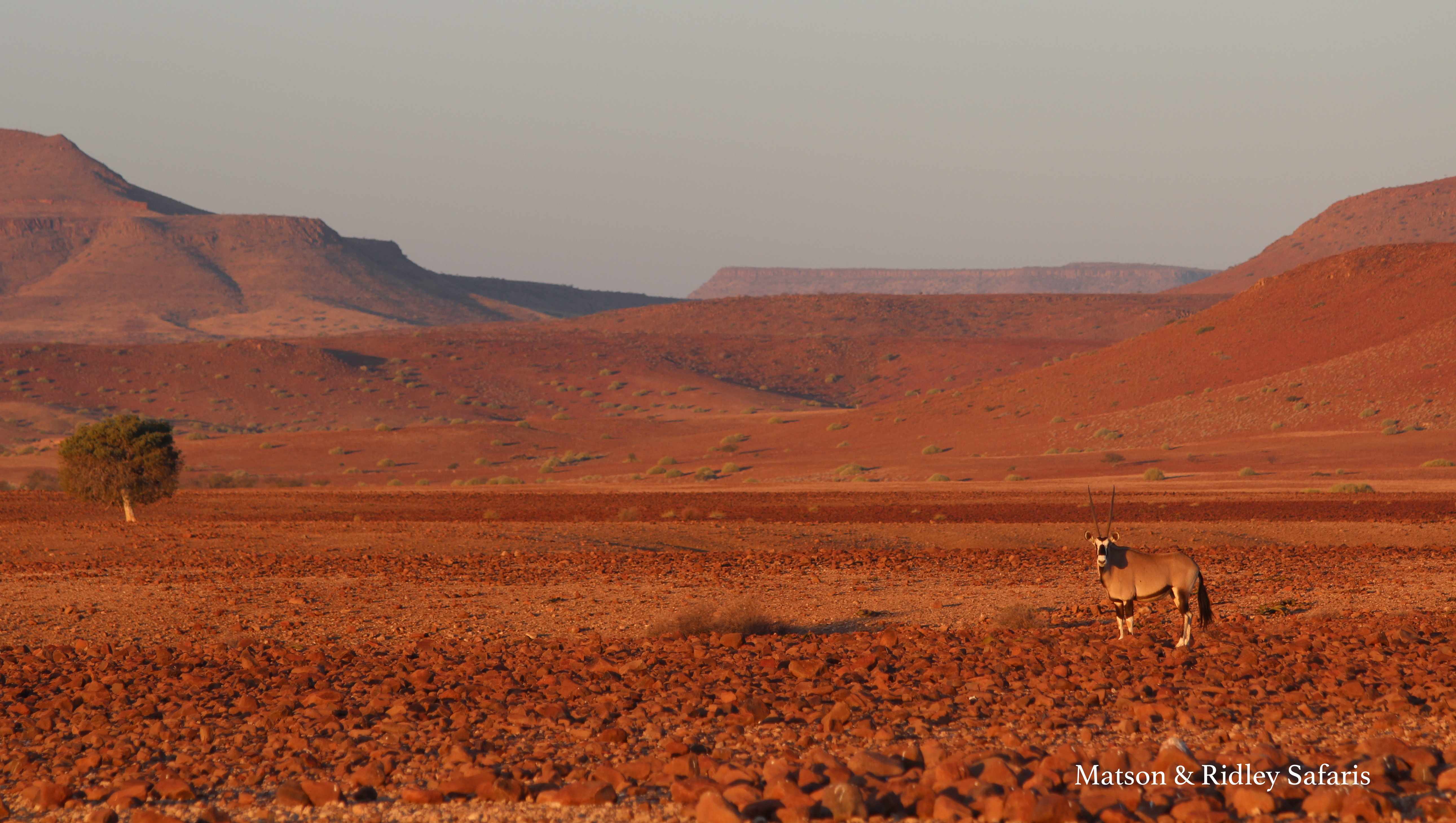
Oryx in Palmwag, Damaraland, near Desert Rhino Camp, a ecotourism partnership between Wilderness Safaris and Save The Rhino Trust, that also benefits 3 local communities.
I believe Namibia is one of the best countries in the world in terms of innovative, practical conservation, largely because of their highly successful community-based conservation efforts, centred around the communal conservancies. There’s no better place to visit than camps like Doro !Nawas Camp, Damaraland Camp, Serra Cafema Camp and Desert Rhino Camp, if you want to see how engaged local communities get when they have genuine ownership over their natural resources. It’s not only the fact that you have locals running these camps, as managers, waiters and guides – it’s the warm feeling you get from the staff, who are not just employees but owners and landlords.
I had a fantastic group of people on safari with me this time, mostly expats from Singapore of Dutch, Indian and American backgrounds, as well as a representative Aussie and a Kenyan! They were all up for an adventure, and that’s certainly what Namibia provides. Flying over the vast landscapes is half the experience, seeing the dune shapes from the air and if you’re lucky, seeing flamingoes and seals along the coast!
We kicked off the safari at Kulala Desert Lodge, the closest camp to the famous Sossusvlei area in the Namib Naukluft Park. I was delighted to find that my research assistant, Munekamba (now known as Ati-Sari), who helped me on my black-faced impala studies in north-west Namibia, is now the manager at Kulala Desert Lodge. If you’ve read my second book “Elephant Dance” you’ll remember the story of the two bull elephants standing over my tent while my assistant looked on from his roof top tent – well, that was Munekamba! After we worked together I introduced him to the managers at one of the Wilderness Safaris camps, and he’s done so well that he’s now managing one of their busiest camps. I’m stoked to say Munekamba saw his first elephant with me back in 2006 – and it was standing over my tent at the time!
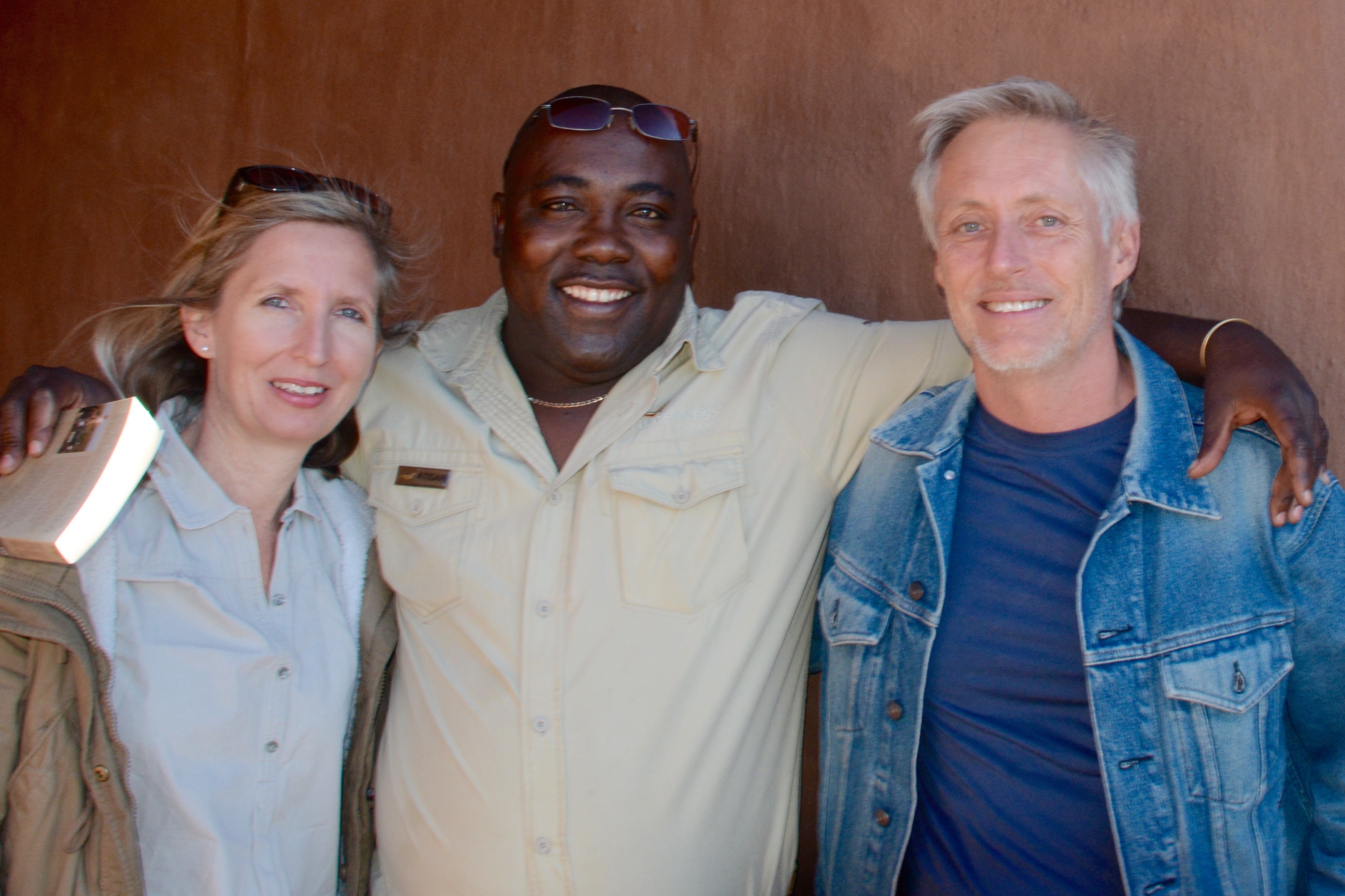
Me with Munekamba, my former research assistant, now known as Ati-Sari as manager of Kulala Desert Ldoge, and my Aussie guest, Robert Livingstone-Ward, who took the most incredible photos (check them out on Facebook – and this one above is also from his camera)
Kulala Desert Lodge is a great place to explore the Namib from. If you want, you can actually sleep on the roofs of the gorgeous chalets, star gazing from your bed as you drift off to sleep, however it wasn’t the best night for it for one of my group, Robert, as during the night a sand storm blew in and he had to make a quick departure inside! It was a wild morning in the dunes, as the more adventurous among us climbed the dunes, being literally blown right off their feet as cyclonic winds whipped across the desiccated landscape.
At Dead Vlei however, it was perfectly calm, somehow protected from the winds by its sunken position. We discovered several fascinating species in the Namib, including the white lady spider and a horned adder at Sesreim Canyon, plus a wonderful spotted eagle owl in a tree near where we stopped for coffee, all well spotted by our excellent Wilderness Safaris guides. But to me it’s always the oryx that steal the show in the Namib, these magnificent antelopes with their black and white markings and sharp, straight horns that make them stand out so strikingly against the pastel colours of the mountains.
Then it was off to Desert Rhino Camp at Palmwag in Damaraland, a place of incredible red, rocky, mountainous landscapes, and home of rare black rhinos who munch on toxic milk bushes (Euphorbia damarana), springbok and oryx, kudu and many more desert- adapted creatures. If the Namib is like landing on the moon, then Damaraland is like going to Mars. Here were were lucky enough to experience spotted hyaenas at a den, including two very young ones who walked right up to our vehicles with not a care in the world.
We joined the Save The Rhino Trust trackers on a walk to see a black rhino they had found earlier that morning, a bull known as “Don’t Worry”, who had been dehorned as part of a Ministry of Environment and Tourism initiative to reduce poaching in Damaraland. It never feels right to me to see a rhino without its horn, and I worry about the ability of the rhinos to defend their young against lions and conduct normal behaviours without this natural appendage. Sadly, there is evidence that poachers will still kill dehorned rhinos for the small amount of horn left below the skin, because of its high value on the illegal market in Vietnam.
There was lots of discussion around the campfire about rhino conservation, and a recurrent theme was the issue of legalising the trade in rhino horn, which seemed to be a popular idea among all the Namibian wardens, guides and rangers I spoke to. Many people in Namibia feel that they should be benefiting from the horns, not the criminals involved in the trade, or that the sales of horn could support rhino conservation. While this makes sense to me, I can’t imagine how wild rhinos, with such low populations today, and continuing to decline at 1000+ per year, could sustain a market in Vietnam, with its growing population of 93 million+ and increasing wealth. In Africa, a single horn can fetch three year’s worth of a local person’s monthly salary, so there are very real incentives for good guys to sacrifice conservation for economic motivation. We have to continue to support anti-poaching efforts in Africa, but I’m more convinced than ever that reducing demand in Vietnam is the most effective weapon we have to stop the slaughter. That’s why I think awareness campaigns in Vietnam (like Breaking the Brand) need much greater support, targeting the elite audience who are buying it. This battle cannot be won in Africa alone.
Desert Rhino Camp is a partnership between Wilderness Safaris and both Save The Rhino Trust and 3 Damara communities surrounding the Palmwag concession. Going there is truly supporting conservation because what you pay to visit directly supports the 3 communities and pays for the trackers to protect the rhino every day in the concession. I love examples of genuine community-based conservation like this, based on sound economic principles. And quite besides the feel good factor of going there and knowing the contribution you’re making makes a real difference, which the staff remind you about all the time by thanking you at least three times a day, the feeling in this camp is just magical. The staff sing and dance every night (and boy, have they got rhythm!), and on our last night they arranged a surprise starlit dinner out in the bush, something that me and my group will never forget. It was the highlight of our Namibian journey.
Finally it was off to see some big animals up close at the Ongava Game Reserve, right next to Etosha National Park. For me this is really home territory as I was based there for two years in a battered old caravan at Okaukeujo research camp while collecting data on black-faced impalas for my PhD. This part of the world is really fantastic in terms of wildlife in September, the dry season, because you get the big concentrations of animals at the waterholes, and on this front it didn’t disappoint. You can simply sit at a waterhole for hours in Etosha at this time of year, just watching the hundreds of animals come and go.
We also spent some time with mating lions in Etosha, walked up to white rhinos at Ongava and shared a cup of coffee at Okaukeujo waterhole with my old friends, Shayne Kotting (MET warden, Okaukeujo) and Birgit Kotting (MET, head of the rhino custodianship program).
I’d like to thank Dr Julian Fennessy of the Giraffe Conservation Foundation for giving us a talk on the plight of Africa’s giraffes on our first night in Windhoek and for joining us for a fun night at Joe’s Beerhouse afterwards. Julian really opened our eyes about the increasingly worrying state of Africa’s giraffe subspecies, and watch the IUCN red list this year which is likely to suggest that quite a few giraffe species are more endangered than we realised.
Thanks also to Abigail Guerier at Ongava Research Centre for the fascinating talk at Ongava on our last day on her work on the genetics of white rhinos. Fascinating to learn about the complex life histories of these prehistoric giants. Let’s just hope they are around for our children to see!
All in all, it was a fantastic life-changing journey, one that I certainly won’t forget, and I hope that all who joined me are now great ambassadors for the cause of conserving Africa’s wildlife. If you’re interested in joining my next Namibian adventure, contact me to sign up for an odyssey in to the ruggedly beautiful Skeleton Coast from 20-27 May next year, limited to 10 people and already half full. And last but not least…
Finally, a very big thanks to Susan van der Vloodt, who brought most of her family and friends along on this magical journey. There’s nothing like sharing an African experience with the ones you love, and for me it’s a real privilege to share Africa with others who love being there as much as I do!
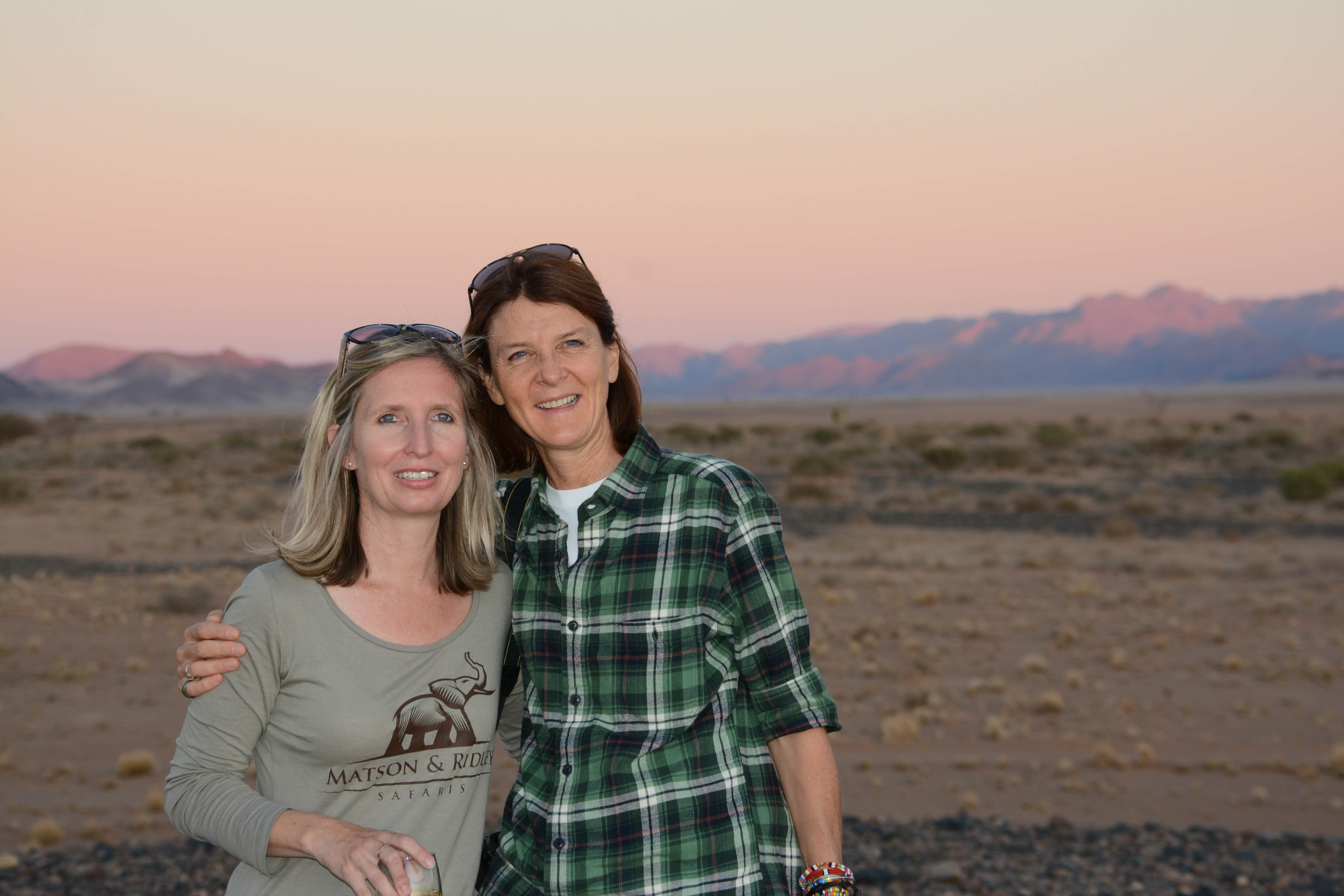
The author with Susan van der Vloodt at sunset in the Namib (thanks Robert Livingstone-Ward for taking this photo)
To see more photos from our Namibian journey, you can like our Matson & Ridley Safaris Facebook page by clicking here and pressing ‘like’.
5 Reasons To Visit Namibia, Land of Big Skies & Desert Dunes
Where should you go on safari in Africa? The choices seem bamboozling at first – Kenya, Tanzania, Zimbabwe, Botswana, South Africa… All are amazing and have their own unique angles and experiences, but I’m going to share a few reasons why I think you should consider one of my favourite safari destinations – Namibia. If my photos below don’t convince you, consider these five reasons why Namibia should be on your bucket list.
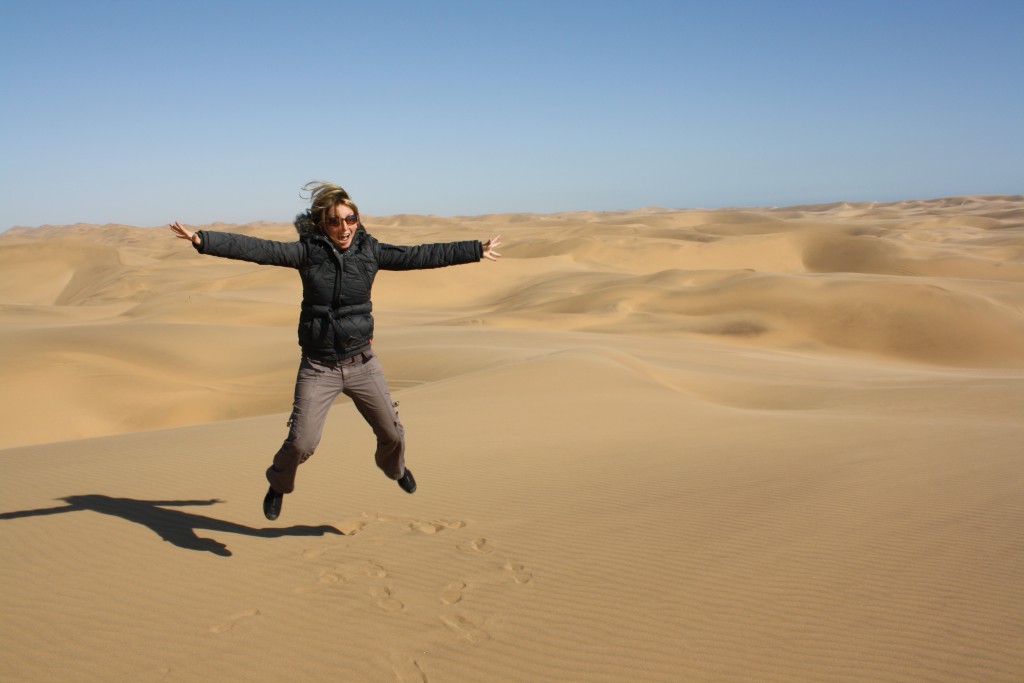
Don’t ask me why, but even if you’re not the kind of person who tends to do random jumps in the sky, Namibia’s vast sands will make you want to
1) Safety.
Namibia is one of the safest countries you can go on an African safari. A whole lot of people don’t realise that there are less safe countries to visit in Africa (Nigeria, Congo and parts of West Africa spring to mind) and there are much safer countries, like Namibia. In my opinion, the two safest places to travel in Africa are Namibia and Botswana, partly because of their low human populations, and secondly because you don’t get the same kind of crime that you get in some other countries (like South Africa). Namibia is fabulous for families and first timers to Africa. We always used to call it “Africa For Beginners”. Lots of people do self drive safaris there because the roads are good and the scenery is spectacular.
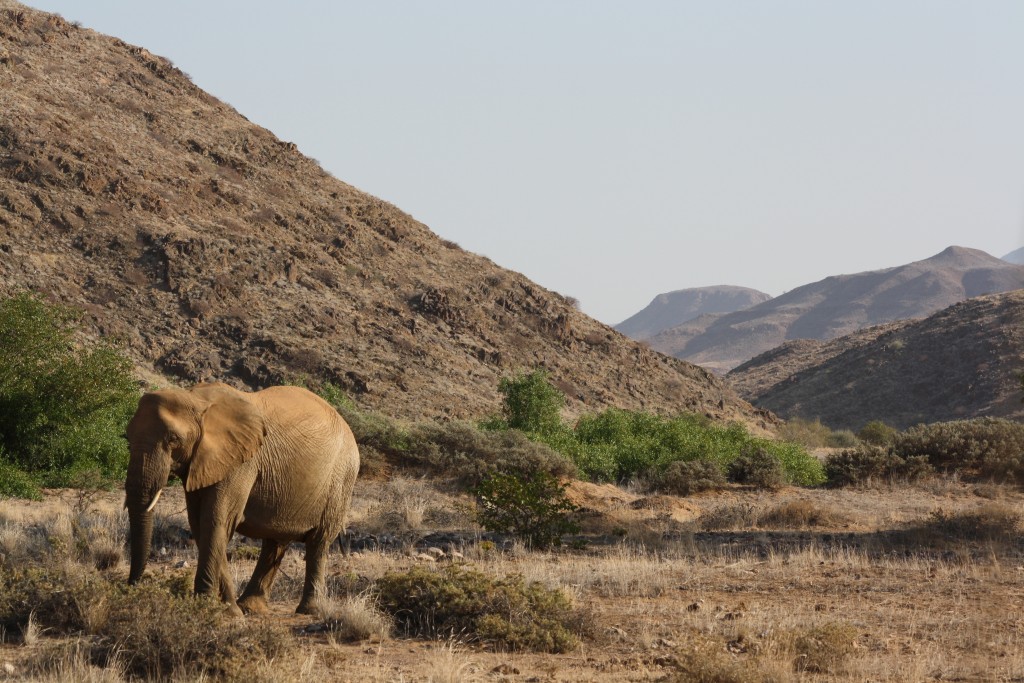
Desert elephants in Namibia. These are savannah elephants with special adaptations to life in the desert.
2) Space.
Most of us live in a world that is full of people living in close proximity to each other. We are constantly bombarded with commercialism and consumerism, bright lights, loud noises, all those things that are part of capitalistic life in the modern world. Namibia’s desert is the opposite of all that. There’s something about being miles from anyone else, enveloped by vast spaces and enormous skies, that provides a unique kind of escapism. For me, it’s a place I can breathe.
3) Conservation.
More than half of Namibia is under conservation protection. I mean, think about that. It’s amazing. Australia’s only got about 12% under protection. It’s not all national parks in that 50%+ under protection in Namibia, although at almost 20% in national parks that’s a big chunk too. The key is all the communal conservancies managed and legally run by the local ethnic groups. Namibia is one of the finest examples of community-based conservation you’ll find on the planet and tourism is a big part of that success story. In Namibia they’ve really got their head around giving local communities benefits from the wildlife, and that translates back to their excellent conservation record. If you book an ethical safari through Matson & Ridley Safaris, you’re directly contributing to this conservation success. Read more about Namibia’s community-based conservation at the website of the Namibia Nature Foundation.
4) Unique wildlife
The safari experience you get in Namibia is like no other. You won’t get all of the ‘Big Five’ (lion, leopard, buffalo, elephant, rhino) on your first game drive. Namibia’s about quality, not quantity. What you will get is a single, regal, solitary oryx antelope standing on the desert dunes at sunset. You’ll get tall, white elephants in Etosha (in the dry season), coloured that way because of the white dust flung off the enormous pan. You’ll get tiny lizards that dance to stop their feet overheating on the boiling hot sand, and desert beetles with tiny ridges on their backs that trap the moisture from fog rolling in from the coast by standing into the wind on a ridge of sand. What you get there is unique desert-adapted wildlife in huge landscapes that even dwarf elephants.
5) Variety
On a single safari, you can experience the sandy orange dunes in the Namib Desert, the red, rocky volcanic landscapes of Damaraland in the north west, thorny bush lands and of course the famous Etosha salt pan fringed by short grasslands. In the north east you get big flowing rivers and in Bushmanland you get ancient, towering baobab trees. It’s incredibly diverse. You do have to cover a bit of distance as it’s a big country, but your money goes a long way in Namibia. There are also at least 11 ethnic groups in Namibia, from the traditional ovaHimba people to the cattle-focused Hereros and the San Bushmen.
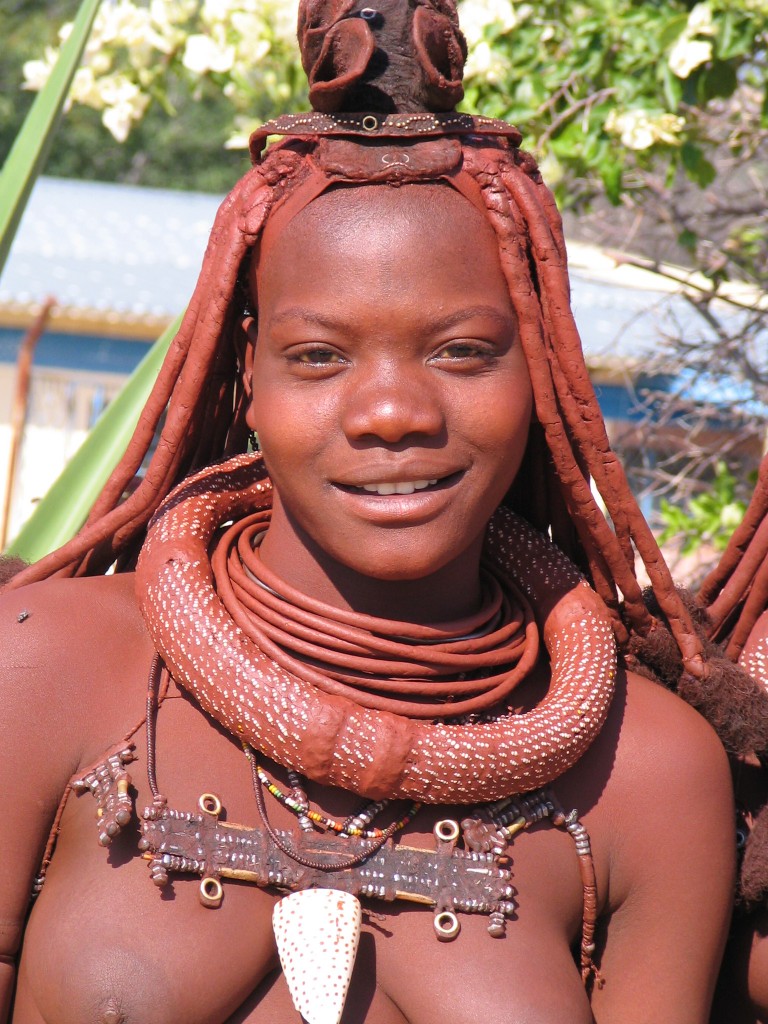
Meeting the local people while on safari is always a highlight, especially in areas where they benefit from the dollars you’re paying to visit them
I’ve got a few places left on my north west Namibia safari in May 2016, and only 1 spot for a single male for this year’s Namibian safari in September, so get in touch if you’d like to experience this amazing part of Africa with me. Alternatively, drop me a line if you’d like to book your own self-drive or fly-in safari in Namibia and I’ll plan an itinerary for you and your family that gives you your dream safari while making a difference in conservation. Namibia’s worth it, trust me!
Price slashed for my Namibian Safari 2015!
Great news! The wonderful folks at Wilderness Safaris have just offered me a huge discount on my conservation safari to Namibia in September 2015 (next year). However, it’s only for a limited time! (more…)

